Strategic Information System
VerifiedAdded on 2022/11/25
|21
|4489
|174
AI Summary
This report includes information regarding the gracious industries, which works in the hardware's and supermarket. The company supplies the electronic parts of the computer in the business market. The report based on the ERP (Enterprise Resource Planning) to manage the business process properly.
Contribute Materials
Your contribution can guide someone’s learning journey. Share your
documents today.
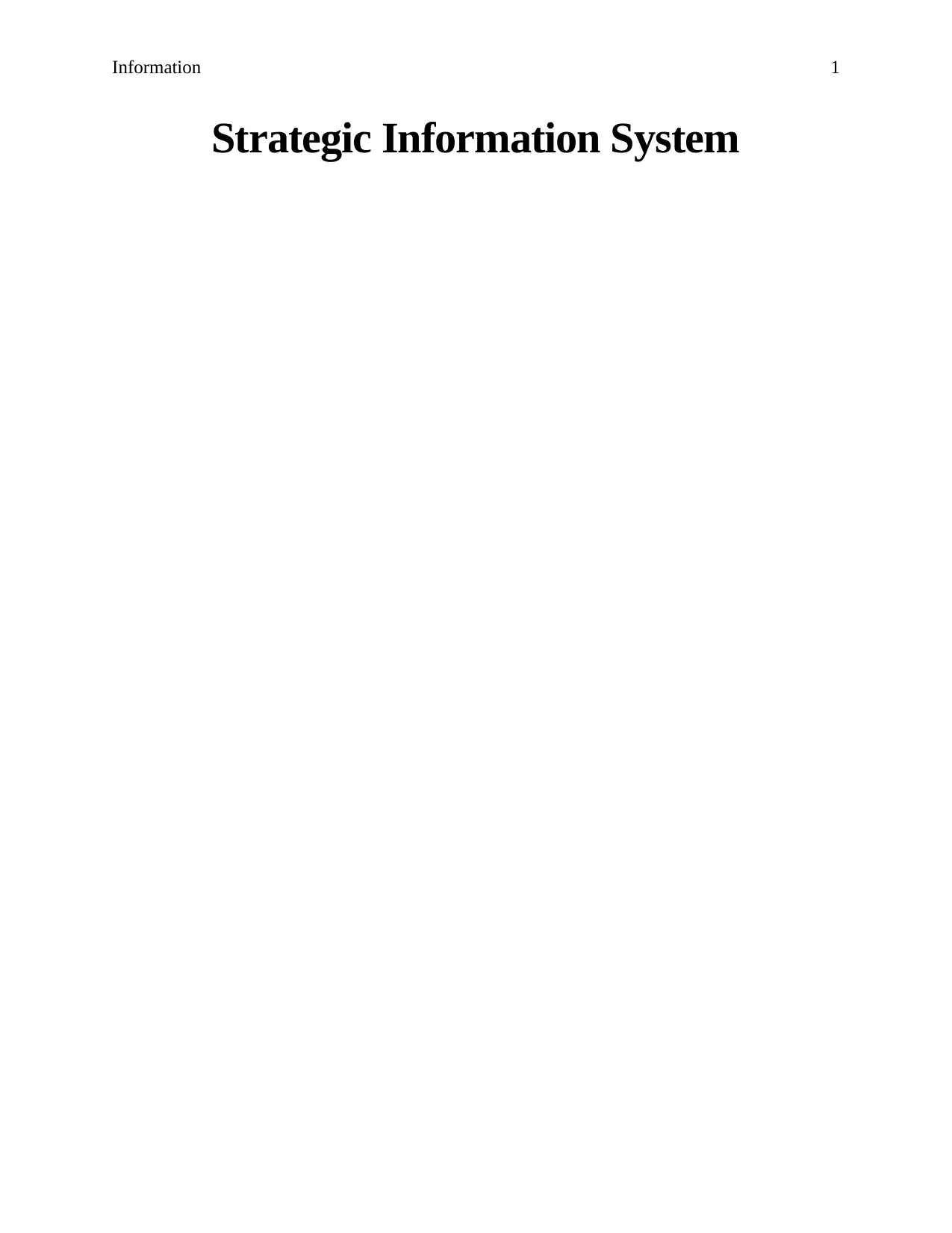
Information 1
Strategic Information System
Strategic Information System
Secure Best Marks with AI Grader
Need help grading? Try our AI Grader for instant feedback on your assignments.
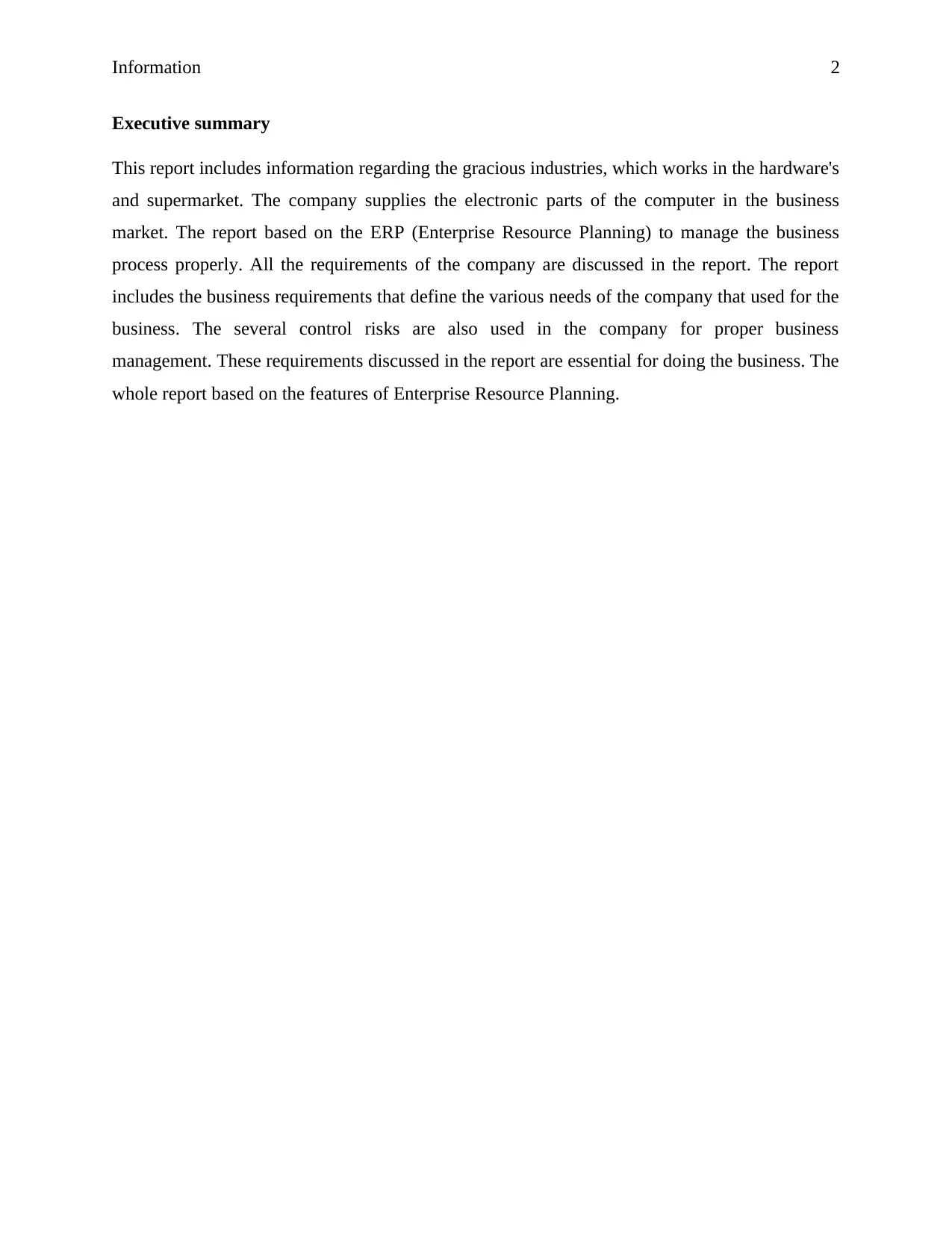
Information 2
Executive summary
This report includes information regarding the gracious industries, which works in the hardware's
and supermarket. The company supplies the electronic parts of the computer in the business
market. The report based on the ERP (Enterprise Resource Planning) to manage the business
process properly. All the requirements of the company are discussed in the report. The report
includes the business requirements that define the various needs of the company that used for the
business. The several control risks are also used in the company for proper business
management. These requirements discussed in the report are essential for doing the business. The
whole report based on the features of Enterprise Resource Planning.
Executive summary
This report includes information regarding the gracious industries, which works in the hardware's
and supermarket. The company supplies the electronic parts of the computer in the business
market. The report based on the ERP (Enterprise Resource Planning) to manage the business
process properly. All the requirements of the company are discussed in the report. The report
includes the business requirements that define the various needs of the company that used for the
business. The several control risks are also used in the company for proper business
management. These requirements discussed in the report are essential for doing the business. The
whole report based on the features of Enterprise Resource Planning.
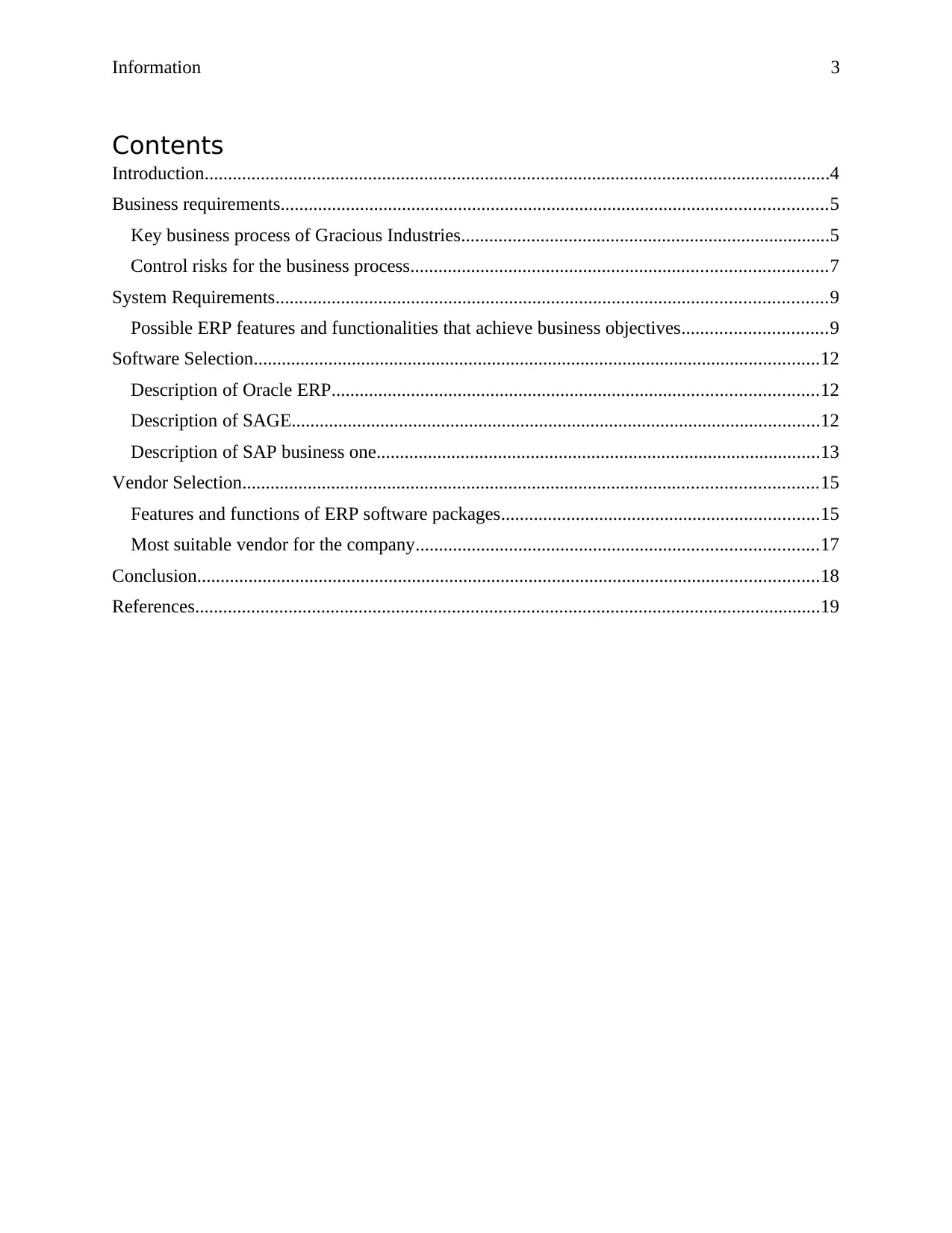
Information 3
Contents
Introduction......................................................................................................................................4
Business requirements.....................................................................................................................5
Key business process of Gracious Industries...............................................................................5
Control risks for the business process.........................................................................................7
System Requirements......................................................................................................................9
Possible ERP features and functionalities that achieve business objectives...............................9
Software Selection.........................................................................................................................12
Description of Oracle ERP........................................................................................................12
Description of SAGE.................................................................................................................12
Description of SAP business one...............................................................................................13
Vendor Selection...........................................................................................................................15
Features and functions of ERP software packages....................................................................15
Most suitable vendor for the company......................................................................................17
Conclusion.....................................................................................................................................18
References......................................................................................................................................19
Contents
Introduction......................................................................................................................................4
Business requirements.....................................................................................................................5
Key business process of Gracious Industries...............................................................................5
Control risks for the business process.........................................................................................7
System Requirements......................................................................................................................9
Possible ERP features and functionalities that achieve business objectives...............................9
Software Selection.........................................................................................................................12
Description of Oracle ERP........................................................................................................12
Description of SAGE.................................................................................................................12
Description of SAP business one...............................................................................................13
Vendor Selection...........................................................................................................................15
Features and functions of ERP software packages....................................................................15
Most suitable vendor for the company......................................................................................17
Conclusion.....................................................................................................................................18
References......................................................................................................................................19
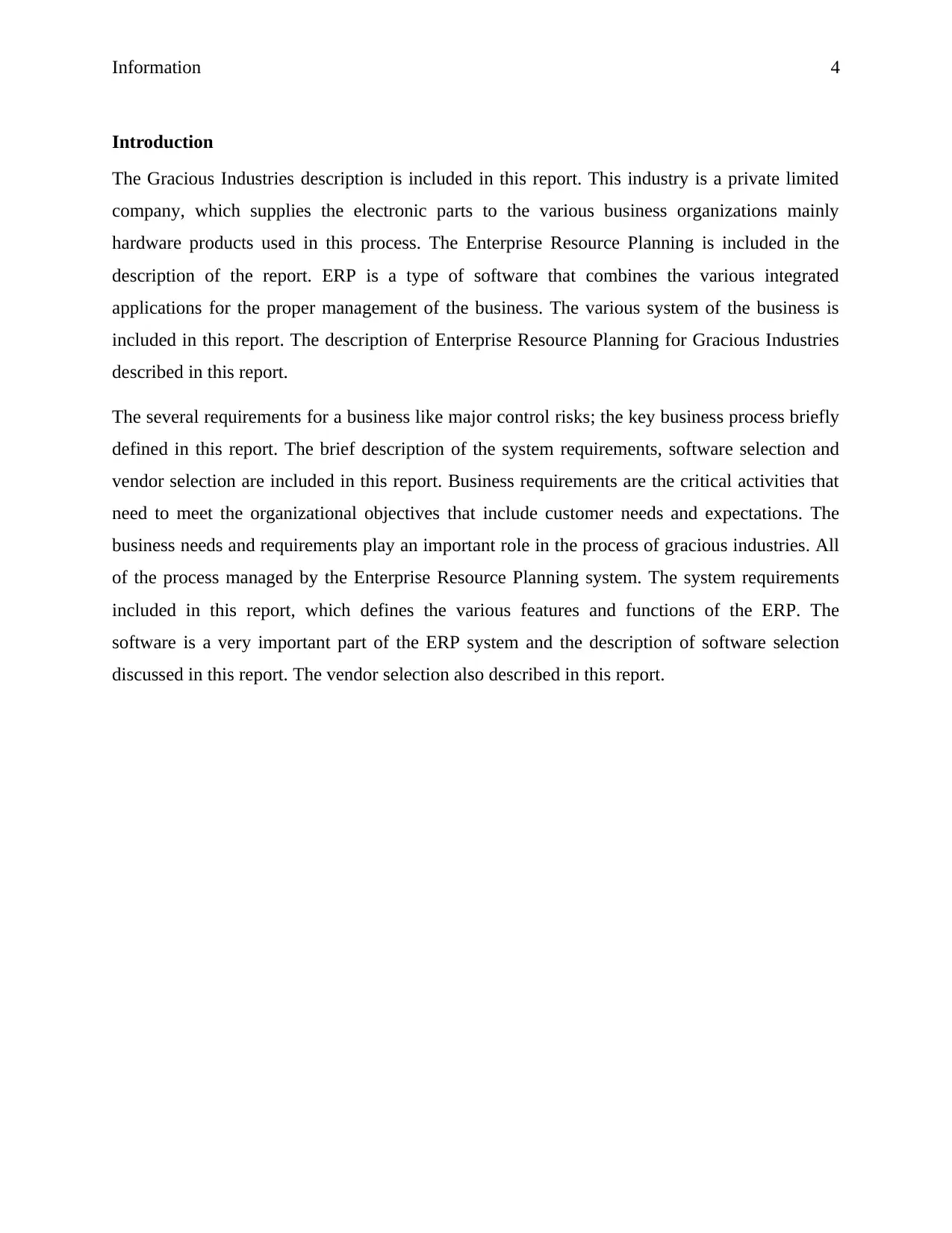
Information 4
Introduction
The Gracious Industries description is included in this report. This industry is a private limited
company, which supplies the electronic parts to the various business organizations mainly
hardware products used in this process. The Enterprise Resource Planning is included in the
description of the report. ERP is a type of software that combines the various integrated
applications for the proper management of the business. The various system of the business is
included in this report. The description of Enterprise Resource Planning for Gracious Industries
described in this report.
The several requirements for a business like major control risks; the key business process briefly
defined in this report. The brief description of the system requirements, software selection and
vendor selection are included in this report. Business requirements are the critical activities that
need to meet the organizational objectives that include customer needs and expectations. The
business needs and requirements play an important role in the process of gracious industries. All
of the process managed by the Enterprise Resource Planning system. The system requirements
included in this report, which defines the various features and functions of the ERP. The
software is a very important part of the ERP system and the description of software selection
discussed in this report. The vendor selection also described in this report.
Introduction
The Gracious Industries description is included in this report. This industry is a private limited
company, which supplies the electronic parts to the various business organizations mainly
hardware products used in this process. The Enterprise Resource Planning is included in the
description of the report. ERP is a type of software that combines the various integrated
applications for the proper management of the business. The various system of the business is
included in this report. The description of Enterprise Resource Planning for Gracious Industries
described in this report.
The several requirements for a business like major control risks; the key business process briefly
defined in this report. The brief description of the system requirements, software selection and
vendor selection are included in this report. Business requirements are the critical activities that
need to meet the organizational objectives that include customer needs and expectations. The
business needs and requirements play an important role in the process of gracious industries. All
of the process managed by the Enterprise Resource Planning system. The system requirements
included in this report, which defines the various features and functions of the ERP. The
software is a very important part of the ERP system and the description of software selection
discussed in this report. The vendor selection also described in this report.
Secure Best Marks with AI Grader
Need help grading? Try our AI Grader for instant feedback on your assignments.
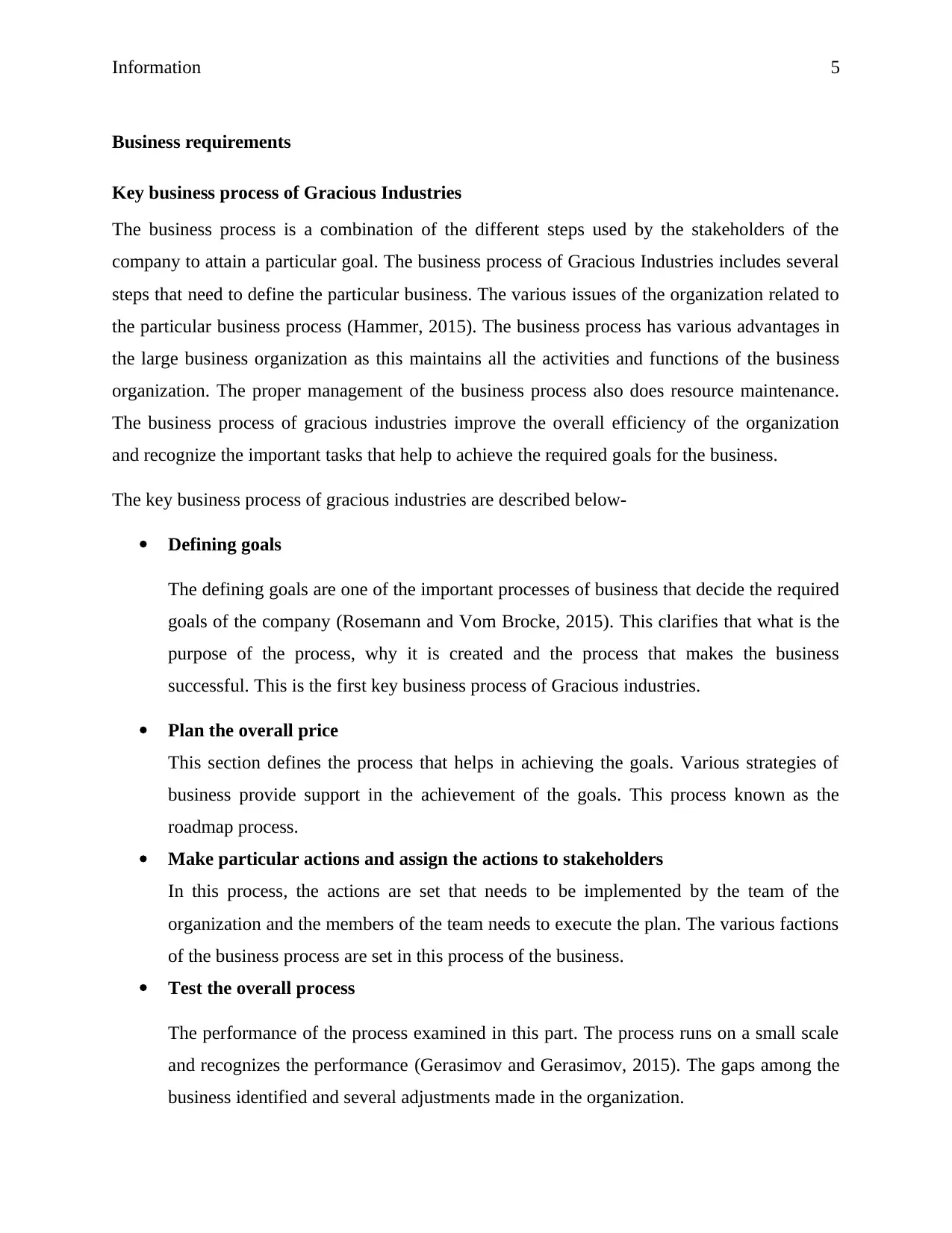
Information 5
Business requirements
Key business process of Gracious Industries
The business process is a combination of the different steps used by the stakeholders of the
company to attain a particular goal. The business process of Gracious Industries includes several
steps that need to define the particular business. The various issues of the organization related to
the particular business process (Hammer, 2015). The business process has various advantages in
the large business organization as this maintains all the activities and functions of the business
organization. The proper management of the business process also does resource maintenance.
The business process of gracious industries improve the overall efficiency of the organization
and recognize the important tasks that help to achieve the required goals for the business.
The key business process of gracious industries are described below-
Defining goals
The defining goals are one of the important processes of business that decide the required
goals of the company (Rosemann and Vom Brocke, 2015). This clarifies that what is the
purpose of the process, why it is created and the process that makes the business
successful. This is the first key business process of Gracious industries.
Plan the overall price
This section defines the process that helps in achieving the goals. Various strategies of
business provide support in the achievement of the goals. This process known as the
roadmap process.
Make particular actions and assign the actions to stakeholders
In this process, the actions are set that needs to be implemented by the team of the
organization and the members of the team needs to execute the plan. The various factions
of the business process are set in this process of the business.
Test the overall process
The performance of the process examined in this part. The process runs on a small scale
and recognizes the performance (Gerasimov and Gerasimov, 2015). The gaps among the
business identified and several adjustments made in the organization.
Business requirements
Key business process of Gracious Industries
The business process is a combination of the different steps used by the stakeholders of the
company to attain a particular goal. The business process of Gracious Industries includes several
steps that need to define the particular business. The various issues of the organization related to
the particular business process (Hammer, 2015). The business process has various advantages in
the large business organization as this maintains all the activities and functions of the business
organization. The proper management of the business process also does resource maintenance.
The business process of gracious industries improve the overall efficiency of the organization
and recognize the important tasks that help to achieve the required goals for the business.
The key business process of gracious industries are described below-
Defining goals
The defining goals are one of the important processes of business that decide the required
goals of the company (Rosemann and Vom Brocke, 2015). This clarifies that what is the
purpose of the process, why it is created and the process that makes the business
successful. This is the first key business process of Gracious industries.
Plan the overall price
This section defines the process that helps in achieving the goals. Various strategies of
business provide support in the achievement of the goals. This process known as the
roadmap process.
Make particular actions and assign the actions to stakeholders
In this process, the actions are set that needs to be implemented by the team of the
organization and the members of the team needs to execute the plan. The various factions
of the business process are set in this process of the business.
Test the overall process
The performance of the process examined in this part. The process runs on a small scale
and recognizes the performance (Gerasimov and Gerasimov, 2015). The gaps among the
business identified and several adjustments made in the organization.
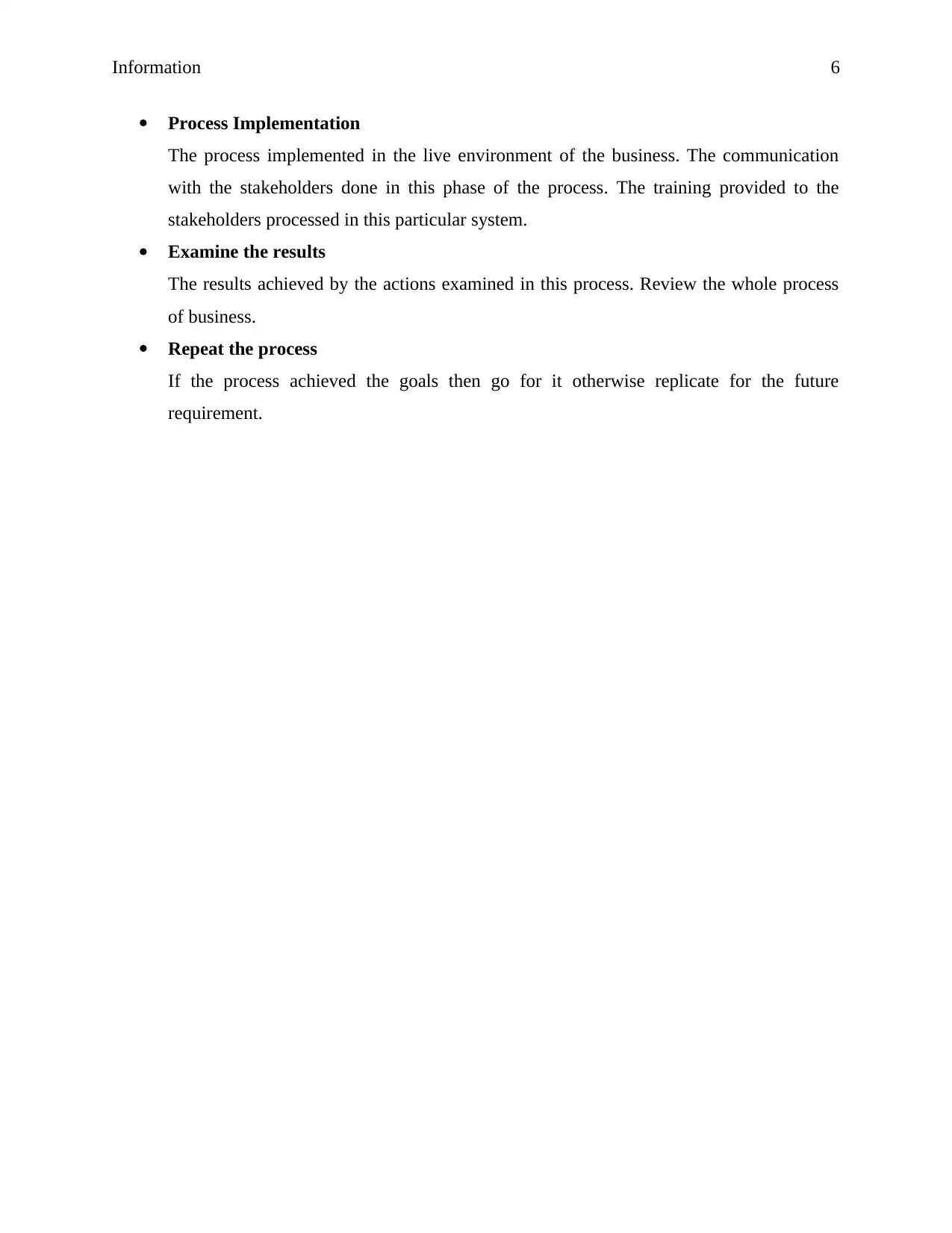
Information 6
Process Implementation
The process implemented in the live environment of the business. The communication
with the stakeholders done in this phase of the process. The training provided to the
stakeholders processed in this particular system.
Examine the results
The results achieved by the actions examined in this process. Review the whole process
of business.
Repeat the process
If the process achieved the goals then go for it otherwise replicate for the future
requirement.
Process Implementation
The process implemented in the live environment of the business. The communication
with the stakeholders done in this phase of the process. The training provided to the
stakeholders processed in this particular system.
Examine the results
The results achieved by the actions examined in this process. Review the whole process
of business.
Repeat the process
If the process achieved the goals then go for it otherwise replicate for the future
requirement.
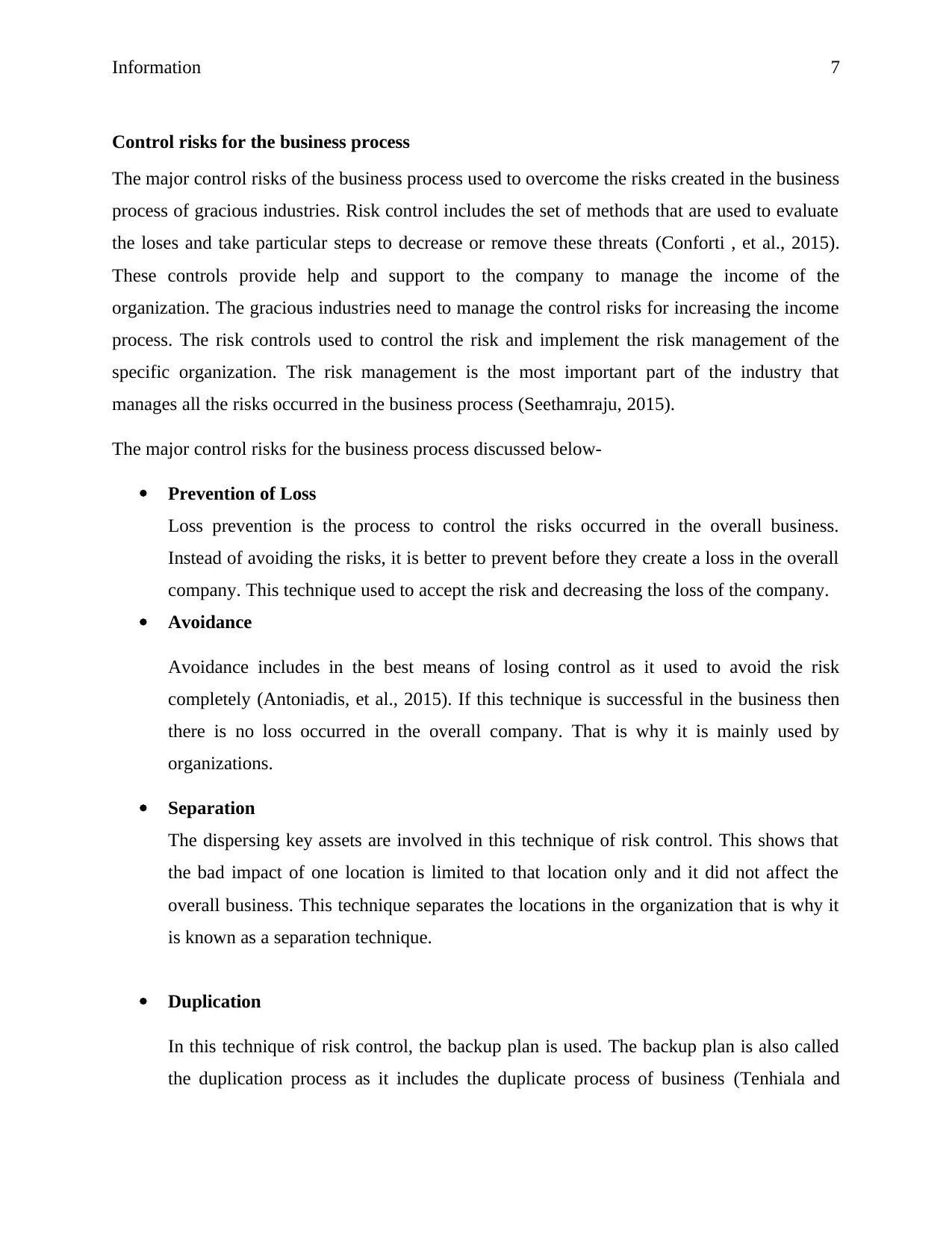
Information 7
Control risks for the business process
The major control risks of the business process used to overcome the risks created in the business
process of gracious industries. Risk control includes the set of methods that are used to evaluate
the loses and take particular steps to decrease or remove these threats (Conforti , et al., 2015).
These controls provide help and support to the company to manage the income of the
organization. The gracious industries need to manage the control risks for increasing the income
process. The risk controls used to control the risk and implement the risk management of the
specific organization. The risk management is the most important part of the industry that
manages all the risks occurred in the business process (Seethamraju, 2015).
The major control risks for the business process discussed below-
Prevention of Loss
Loss prevention is the process to control the risks occurred in the overall business.
Instead of avoiding the risks, it is better to prevent before they create a loss in the overall
company. This technique used to accept the risk and decreasing the loss of the company.
Avoidance
Avoidance includes in the best means of losing control as it used to avoid the risk
completely (Antoniadis, et al., 2015). If this technique is successful in the business then
there is no loss occurred in the overall company. That is why it is mainly used by
organizations.
Separation
The dispersing key assets are involved in this technique of risk control. This shows that
the bad impact of one location is limited to that location only and it did not affect the
overall business. This technique separates the locations in the organization that is why it
is known as a separation technique.
Duplication
In this technique of risk control, the backup plan is used. The backup plan is also called
the duplication process as it includes the duplicate process of business (Tenhiala and
Control risks for the business process
The major control risks of the business process used to overcome the risks created in the business
process of gracious industries. Risk control includes the set of methods that are used to evaluate
the loses and take particular steps to decrease or remove these threats (Conforti , et al., 2015).
These controls provide help and support to the company to manage the income of the
organization. The gracious industries need to manage the control risks for increasing the income
process. The risk controls used to control the risk and implement the risk management of the
specific organization. The risk management is the most important part of the industry that
manages all the risks occurred in the business process (Seethamraju, 2015).
The major control risks for the business process discussed below-
Prevention of Loss
Loss prevention is the process to control the risks occurred in the overall business.
Instead of avoiding the risks, it is better to prevent before they create a loss in the overall
company. This technique used to accept the risk and decreasing the loss of the company.
Avoidance
Avoidance includes in the best means of losing control as it used to avoid the risk
completely (Antoniadis, et al., 2015). If this technique is successful in the business then
there is no loss occurred in the overall company. That is why it is mainly used by
organizations.
Separation
The dispersing key assets are involved in this technique of risk control. This shows that
the bad impact of one location is limited to that location only and it did not affect the
overall business. This technique separates the locations in the organization that is why it
is known as a separation technique.
Duplication
In this technique of risk control, the backup plan is used. The backup plan is also called
the duplication process as it includes the duplicate process of business (Tenhiala and
Paraphrase This Document
Need a fresh take? Get an instant paraphrase of this document with our AI Paraphraser
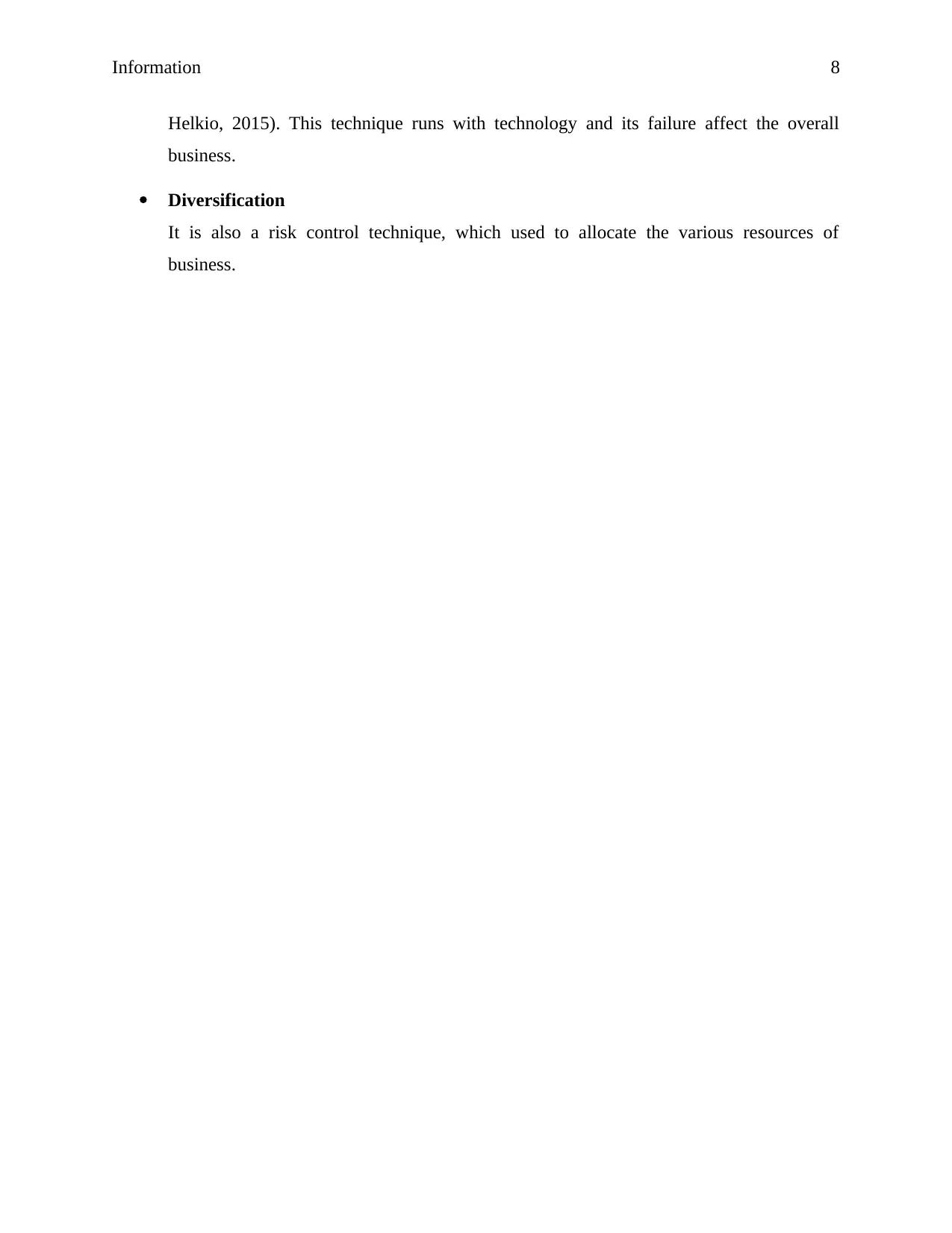
Information 8
Helkio, 2015). This technique runs with technology and its failure affect the overall
business.
Diversification
It is also a risk control technique, which used to allocate the various resources of
business.
Helkio, 2015). This technique runs with technology and its failure affect the overall
business.
Diversification
It is also a risk control technique, which used to allocate the various resources of
business.
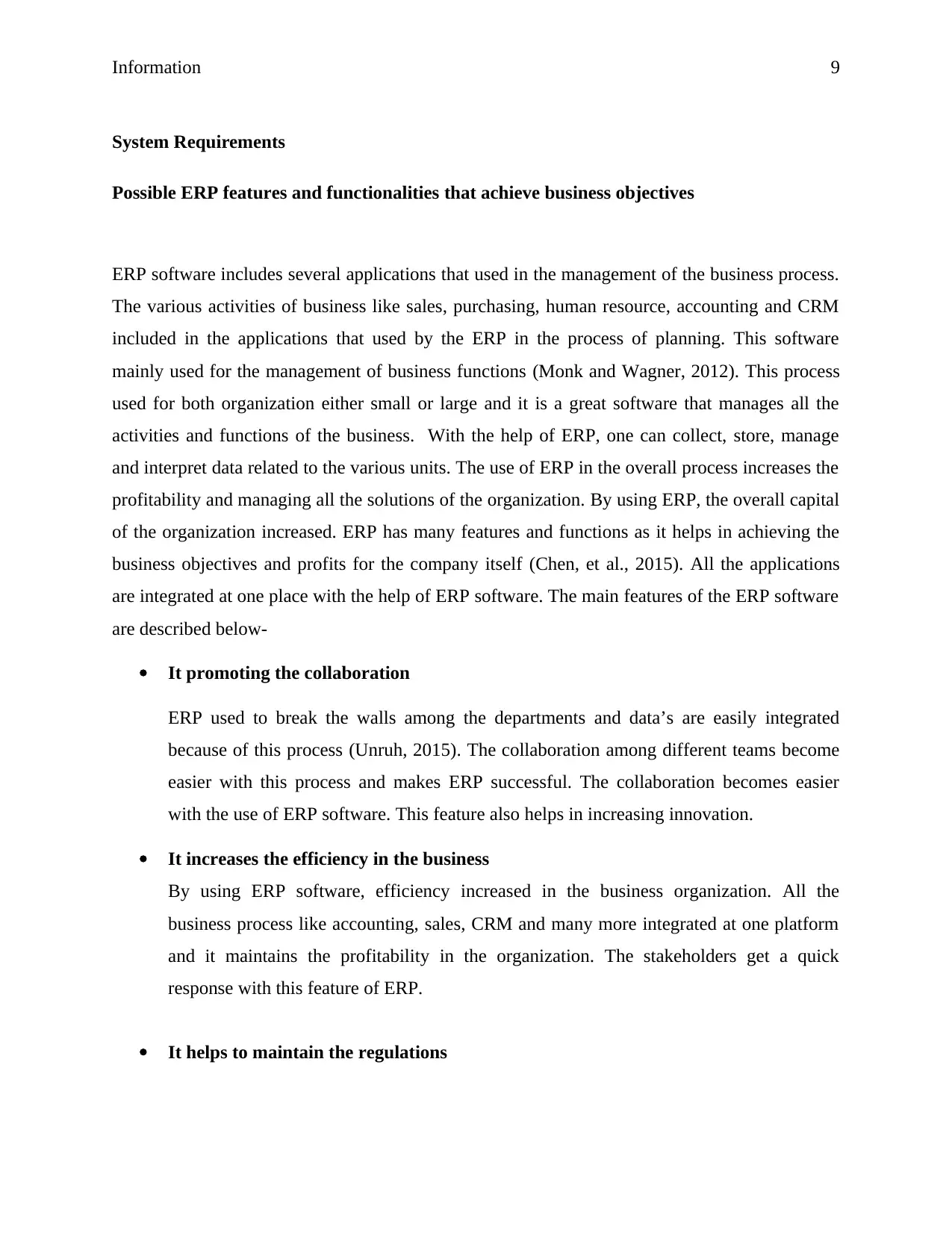
Information 9
System Requirements
Possible ERP features and functionalities that achieve business objectives
ERP software includes several applications that used in the management of the business process.
The various activities of business like sales, purchasing, human resource, accounting and CRM
included in the applications that used by the ERP in the process of planning. This software
mainly used for the management of business functions (Monk and Wagner, 2012). This process
used for both organization either small or large and it is a great software that manages all the
activities and functions of the business. With the help of ERP, one can collect, store, manage
and interpret data related to the various units. The use of ERP in the overall process increases the
profitability and managing all the solutions of the organization. By using ERP, the overall capital
of the organization increased. ERP has many features and functions as it helps in achieving the
business objectives and profits for the company itself (Chen, et al., 2015). All the applications
are integrated at one place with the help of ERP software. The main features of the ERP software
are described below-
It promoting the collaboration
ERP used to break the walls among the departments and data’s are easily integrated
because of this process (Unruh, 2015). The collaboration among different teams become
easier with this process and makes ERP successful. The collaboration becomes easier
with the use of ERP software. This feature also helps in increasing innovation.
It increases the efficiency in the business
By using ERP software, efficiency increased in the business organization. All the
business process like accounting, sales, CRM and many more integrated at one platform
and it maintains the profitability in the organization. The stakeholders get a quick
response with this feature of ERP.
It helps to maintain the regulations
System Requirements
Possible ERP features and functionalities that achieve business objectives
ERP software includes several applications that used in the management of the business process.
The various activities of business like sales, purchasing, human resource, accounting and CRM
included in the applications that used by the ERP in the process of planning. This software
mainly used for the management of business functions (Monk and Wagner, 2012). This process
used for both organization either small or large and it is a great software that manages all the
activities and functions of the business. With the help of ERP, one can collect, store, manage
and interpret data related to the various units. The use of ERP in the overall process increases the
profitability and managing all the solutions of the organization. By using ERP, the overall capital
of the organization increased. ERP has many features and functions as it helps in achieving the
business objectives and profits for the company itself (Chen, et al., 2015). All the applications
are integrated at one place with the help of ERP software. The main features of the ERP software
are described below-
It promoting the collaboration
ERP used to break the walls among the departments and data’s are easily integrated
because of this process (Unruh, 2015). The collaboration among different teams become
easier with this process and makes ERP successful. The collaboration becomes easier
with the use of ERP software. This feature also helps in increasing innovation.
It increases the efficiency in the business
By using ERP software, efficiency increased in the business organization. All the
business process like accounting, sales, CRM and many more integrated at one platform
and it maintains the profitability in the organization. The stakeholders get a quick
response with this feature of ERP.
It helps to maintain the regulations
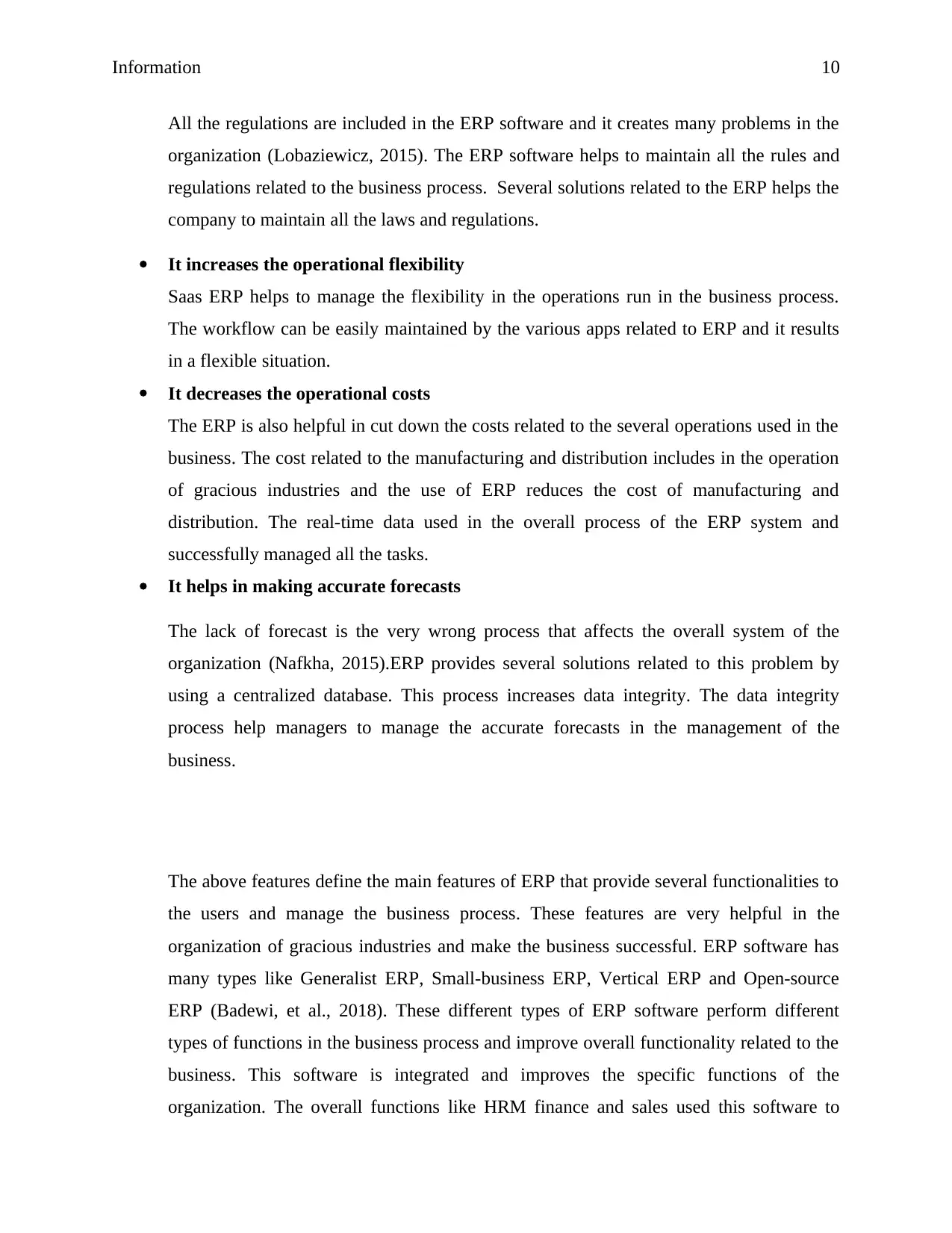
Information 10
All the regulations are included in the ERP software and it creates many problems in the
organization (Lobaziewicz, 2015). The ERP software helps to maintain all the rules and
regulations related to the business process. Several solutions related to the ERP helps the
company to maintain all the laws and regulations.
It increases the operational flexibility
Saas ERP helps to manage the flexibility in the operations run in the business process.
The workflow can be easily maintained by the various apps related to ERP and it results
in a flexible situation.
It decreases the operational costs
The ERP is also helpful in cut down the costs related to the several operations used in the
business. The cost related to the manufacturing and distribution includes in the operation
of gracious industries and the use of ERP reduces the cost of manufacturing and
distribution. The real-time data used in the overall process of the ERP system and
successfully managed all the tasks.
It helps in making accurate forecasts
The lack of forecast is the very wrong process that affects the overall system of the
organization (Nafkha, 2015).ERP provides several solutions related to this problem by
using a centralized database. This process increases data integrity. The data integrity
process help managers to manage the accurate forecasts in the management of the
business.
The above features define the main features of ERP that provide several functionalities to
the users and manage the business process. These features are very helpful in the
organization of gracious industries and make the business successful. ERP software has
many types like Generalist ERP, Small-business ERP, Vertical ERP and Open-source
ERP (Badewi, et al., 2018). These different types of ERP software perform different
types of functions in the business process and improve overall functionality related to the
business. This software is integrated and improves the specific functions of the
organization. The overall functions like HRM finance and sales used this software to
All the regulations are included in the ERP software and it creates many problems in the
organization (Lobaziewicz, 2015). The ERP software helps to maintain all the rules and
regulations related to the business process. Several solutions related to the ERP helps the
company to maintain all the laws and regulations.
It increases the operational flexibility
Saas ERP helps to manage the flexibility in the operations run in the business process.
The workflow can be easily maintained by the various apps related to ERP and it results
in a flexible situation.
It decreases the operational costs
The ERP is also helpful in cut down the costs related to the several operations used in the
business. The cost related to the manufacturing and distribution includes in the operation
of gracious industries and the use of ERP reduces the cost of manufacturing and
distribution. The real-time data used in the overall process of the ERP system and
successfully managed all the tasks.
It helps in making accurate forecasts
The lack of forecast is the very wrong process that affects the overall system of the
organization (Nafkha, 2015).ERP provides several solutions related to this problem by
using a centralized database. This process increases data integrity. The data integrity
process help managers to manage the accurate forecasts in the management of the
business.
The above features define the main features of ERP that provide several functionalities to
the users and manage the business process. These features are very helpful in the
organization of gracious industries and make the business successful. ERP software has
many types like Generalist ERP, Small-business ERP, Vertical ERP and Open-source
ERP (Badewi, et al., 2018). These different types of ERP software perform different
types of functions in the business process and improve overall functionality related to the
business. This software is integrated and improves the specific functions of the
organization. The overall functions like HRM finance and sales used this software to
Secure Best Marks with AI Grader
Need help grading? Try our AI Grader for instant feedback on your assignments.
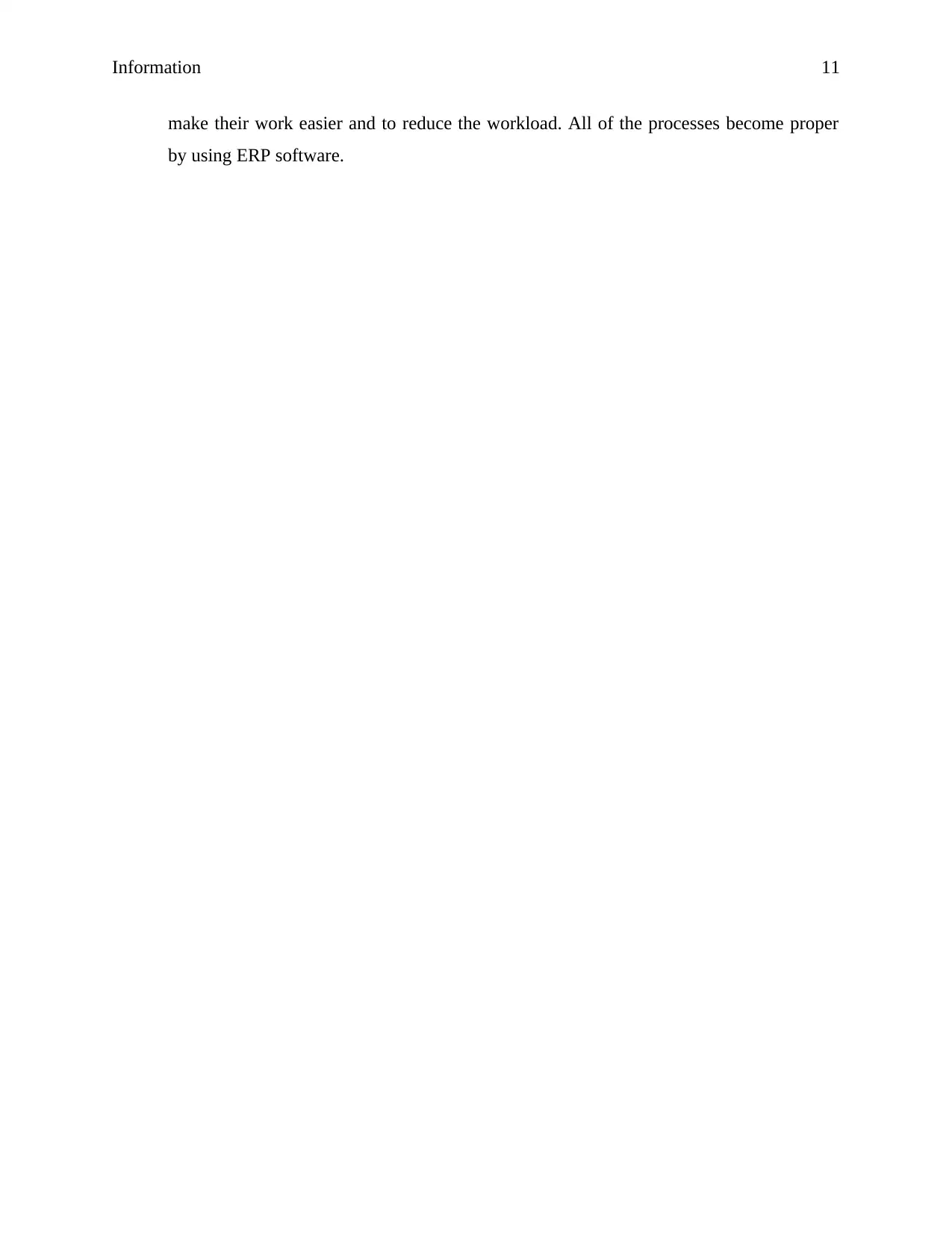
Information 11
make their work easier and to reduce the workload. All of the processes become proper
by using ERP software.
make their work easier and to reduce the workload. All of the processes become proper
by using ERP software.
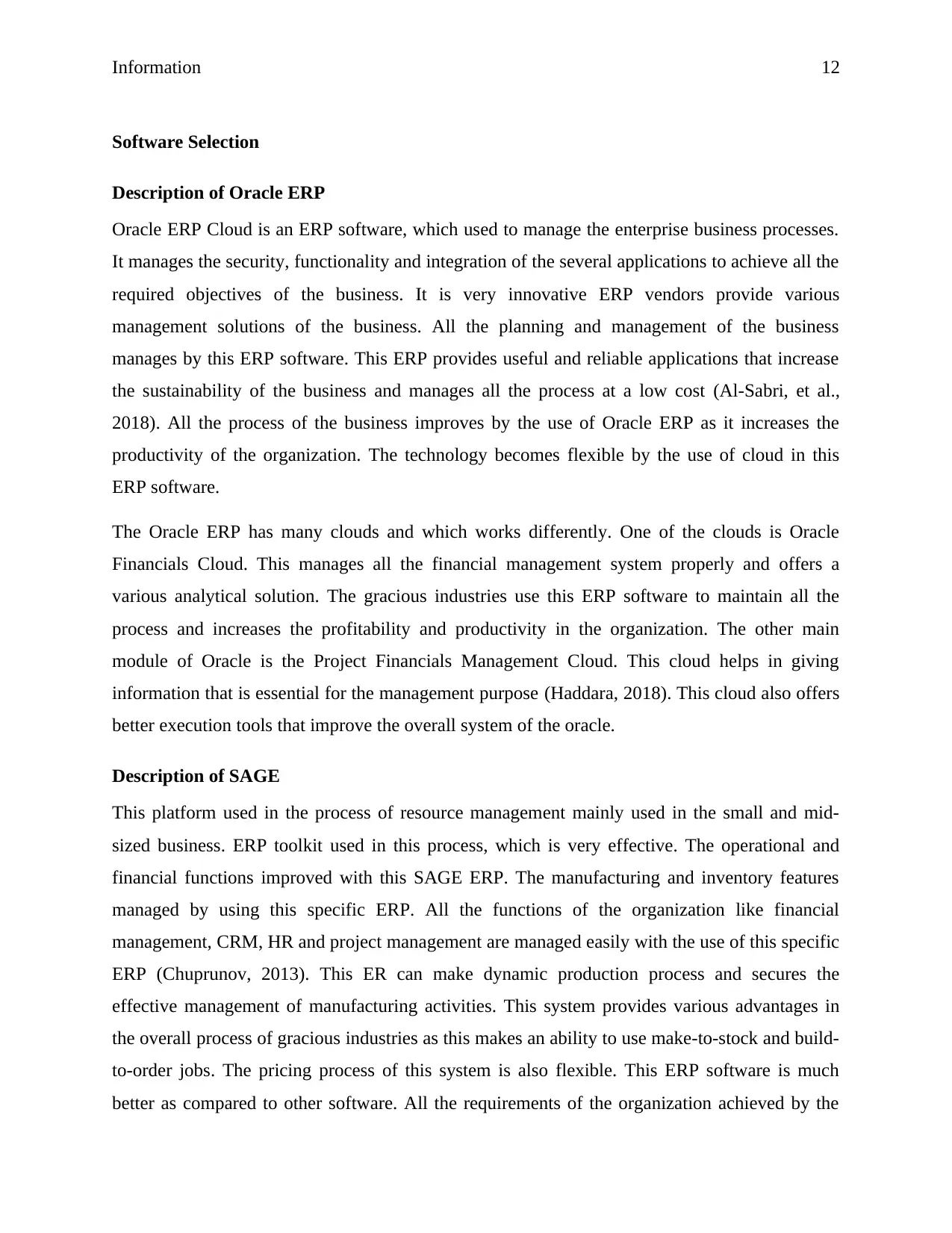
Information 12
Software Selection
Description of Oracle ERP
Oracle ERP Cloud is an ERP software, which used to manage the enterprise business processes.
It manages the security, functionality and integration of the several applications to achieve all the
required objectives of the business. It is very innovative ERP vendors provide various
management solutions of the business. All the planning and management of the business
manages by this ERP software. This ERP provides useful and reliable applications that increase
the sustainability of the business and manages all the process at a low cost (Al-Sabri, et al.,
2018). All the process of the business improves by the use of Oracle ERP as it increases the
productivity of the organization. The technology becomes flexible by the use of cloud in this
ERP software.
The Oracle ERP has many clouds and which works differently. One of the clouds is Oracle
Financials Cloud. This manages all the financial management system properly and offers a
various analytical solution. The gracious industries use this ERP software to maintain all the
process and increases the profitability and productivity in the organization. The other main
module of Oracle is the Project Financials Management Cloud. This cloud helps in giving
information that is essential for the management purpose (Haddara, 2018). This cloud also offers
better execution tools that improve the overall system of the oracle.
Description of SAGE
This platform used in the process of resource management mainly used in the small and mid-
sized business. ERP toolkit used in this process, which is very effective. The operational and
financial functions improved with this SAGE ERP. The manufacturing and inventory features
managed by using this specific ERP. All the functions of the organization like financial
management, CRM, HR and project management are managed easily with the use of this specific
ERP (Chuprunov, 2013). This ER can make dynamic production process and secures the
effective management of manufacturing activities. This system provides various advantages in
the overall process of gracious industries as this makes an ability to use make-to-stock and build-
to-order jobs. The pricing process of this system is also flexible. This ERP software is much
better as compared to other software. All the requirements of the organization achieved by the
Software Selection
Description of Oracle ERP
Oracle ERP Cloud is an ERP software, which used to manage the enterprise business processes.
It manages the security, functionality and integration of the several applications to achieve all the
required objectives of the business. It is very innovative ERP vendors provide various
management solutions of the business. All the planning and management of the business
manages by this ERP software. This ERP provides useful and reliable applications that increase
the sustainability of the business and manages all the process at a low cost (Al-Sabri, et al.,
2018). All the process of the business improves by the use of Oracle ERP as it increases the
productivity of the organization. The technology becomes flexible by the use of cloud in this
ERP software.
The Oracle ERP has many clouds and which works differently. One of the clouds is Oracle
Financials Cloud. This manages all the financial management system properly and offers a
various analytical solution. The gracious industries use this ERP software to maintain all the
process and increases the profitability and productivity in the organization. The other main
module of Oracle is the Project Financials Management Cloud. This cloud helps in giving
information that is essential for the management purpose (Haddara, 2018). This cloud also offers
better execution tools that improve the overall system of the oracle.
Description of SAGE
This platform used in the process of resource management mainly used in the small and mid-
sized business. ERP toolkit used in this process, which is very effective. The operational and
financial functions improved with this SAGE ERP. The manufacturing and inventory features
managed by using this specific ERP. All the functions of the organization like financial
management, CRM, HR and project management are managed easily with the use of this specific
ERP (Chuprunov, 2013). This ER can make dynamic production process and secures the
effective management of manufacturing activities. This system provides various advantages in
the overall process of gracious industries as this makes an ability to use make-to-stock and build-
to-order jobs. The pricing process of this system is also flexible. This ERP software is much
better as compared to other software. All the requirements of the organization achieved by the
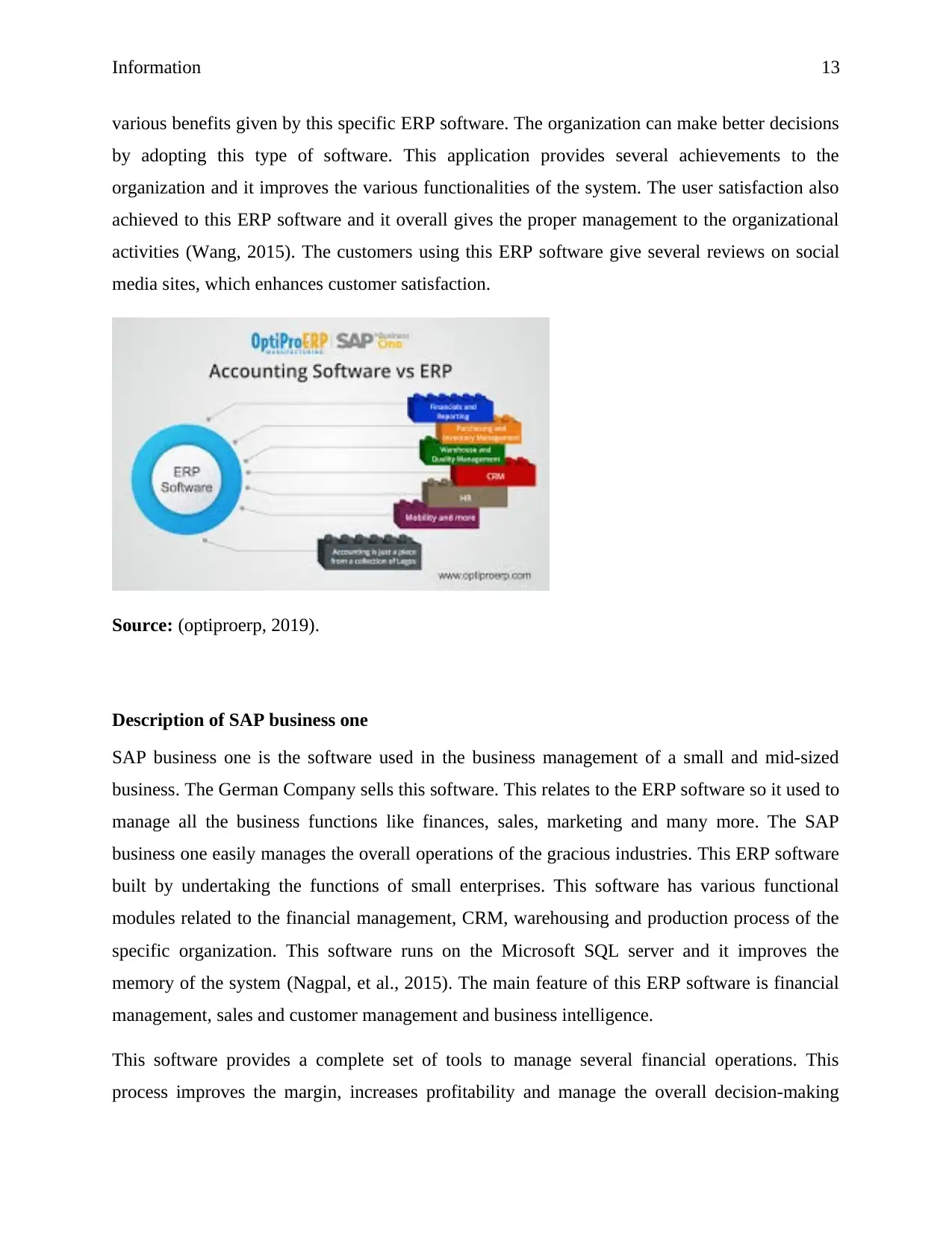
Information 13
various benefits given by this specific ERP software. The organization can make better decisions
by adopting this type of software. This application provides several achievements to the
organization and it improves the various functionalities of the system. The user satisfaction also
achieved to this ERP software and it overall gives the proper management to the organizational
activities (Wang, 2015). The customers using this ERP software give several reviews on social
media sites, which enhances customer satisfaction.
Source: (optiproerp, 2019).
Description of SAP business one
SAP business one is the software used in the business management of a small and mid-sized
business. The German Company sells this software. This relates to the ERP software so it used to
manage all the business functions like finances, sales, marketing and many more. The SAP
business one easily manages the overall operations of the gracious industries. This ERP software
built by undertaking the functions of small enterprises. This software has various functional
modules related to the financial management, CRM, warehousing and production process of the
specific organization. This software runs on the Microsoft SQL server and it improves the
memory of the system (Nagpal, et al., 2015). The main feature of this ERP software is financial
management, sales and customer management and business intelligence.
This software provides a complete set of tools to manage several financial operations. This
process improves the margin, increases profitability and manage the overall decision-making
various benefits given by this specific ERP software. The organization can make better decisions
by adopting this type of software. This application provides several achievements to the
organization and it improves the various functionalities of the system. The user satisfaction also
achieved to this ERP software and it overall gives the proper management to the organizational
activities (Wang, 2015). The customers using this ERP software give several reviews on social
media sites, which enhances customer satisfaction.
Source: (optiproerp, 2019).
Description of SAP business one
SAP business one is the software used in the business management of a small and mid-sized
business. The German Company sells this software. This relates to the ERP software so it used to
manage all the business functions like finances, sales, marketing and many more. The SAP
business one easily manages the overall operations of the gracious industries. This ERP software
built by undertaking the functions of small enterprises. This software has various functional
modules related to the financial management, CRM, warehousing and production process of the
specific organization. This software runs on the Microsoft SQL server and it improves the
memory of the system (Nagpal, et al., 2015). The main feature of this ERP software is financial
management, sales and customer management and business intelligence.
This software provides a complete set of tools to manage several financial operations. This
process improves the margin, increases profitability and manage the overall decision-making
Paraphrase This Document
Need a fresh take? Get an instant paraphrase of this document with our AI Paraphraser
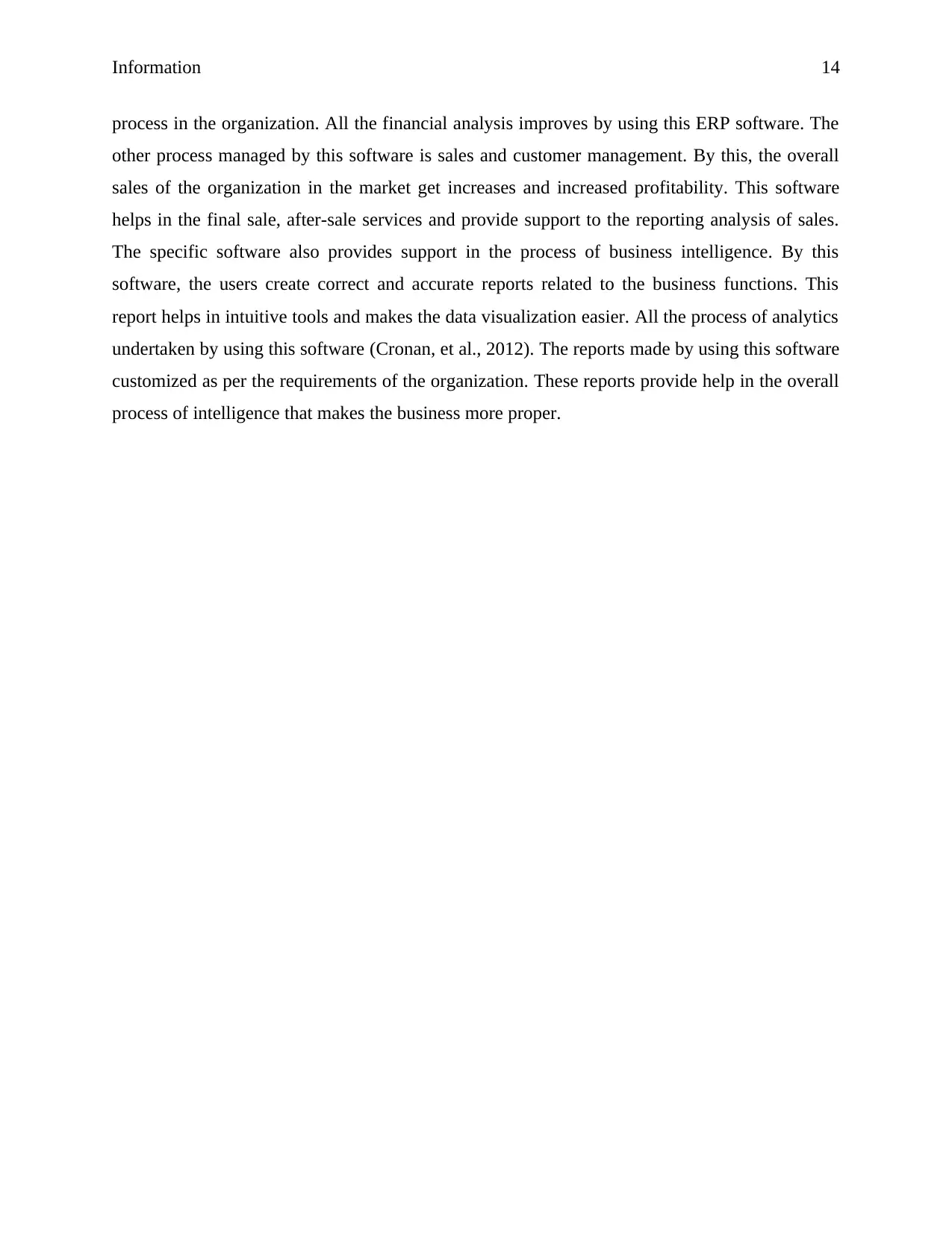
Information 14
process in the organization. All the financial analysis improves by using this ERP software. The
other process managed by this software is sales and customer management. By this, the overall
sales of the organization in the market get increases and increased profitability. This software
helps in the final sale, after-sale services and provide support to the reporting analysis of sales.
The specific software also provides support in the process of business intelligence. By this
software, the users create correct and accurate reports related to the business functions. This
report helps in intuitive tools and makes the data visualization easier. All the process of analytics
undertaken by using this software (Cronan, et al., 2012). The reports made by using this software
customized as per the requirements of the organization. These reports provide help in the overall
process of intelligence that makes the business more proper.
process in the organization. All the financial analysis improves by using this ERP software. The
other process managed by this software is sales and customer management. By this, the overall
sales of the organization in the market get increases and increased profitability. This software
helps in the final sale, after-sale services and provide support to the reporting analysis of sales.
The specific software also provides support in the process of business intelligence. By this
software, the users create correct and accurate reports related to the business functions. This
report helps in intuitive tools and makes the data visualization easier. All the process of analytics
undertaken by using this software (Cronan, et al., 2012). The reports made by using this software
customized as per the requirements of the organization. These reports provide help in the overall
process of intelligence that makes the business more proper.
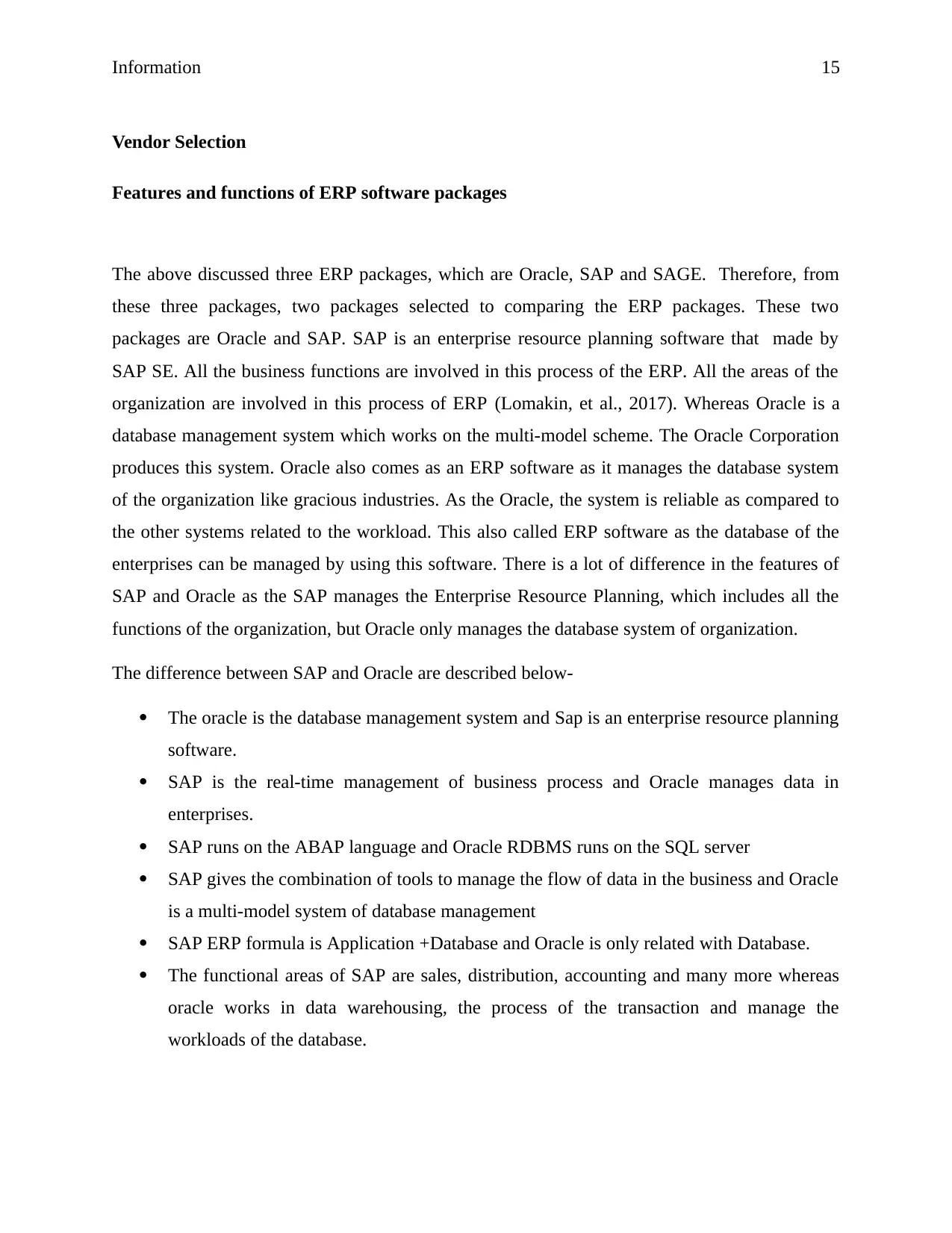
Information 15
Vendor Selection
Features and functions of ERP software packages
The above discussed three ERP packages, which are Oracle, SAP and SAGE. Therefore, from
these three packages, two packages selected to comparing the ERP packages. These two
packages are Oracle and SAP. SAP is an enterprise resource planning software that made by
SAP SE. All the business functions are involved in this process of the ERP. All the areas of the
organization are involved in this process of ERP (Lomakin, et al., 2017). Whereas Oracle is a
database management system which works on the multi-model scheme. The Oracle Corporation
produces this system. Oracle also comes as an ERP software as it manages the database system
of the organization like gracious industries. As the Oracle, the system is reliable as compared to
the other systems related to the workload. This also called ERP software as the database of the
enterprises can be managed by using this software. There is a lot of difference in the features of
SAP and Oracle as the SAP manages the Enterprise Resource Planning, which includes all the
functions of the organization, but Oracle only manages the database system of organization.
The difference between SAP and Oracle are described below-
The oracle is the database management system and Sap is an enterprise resource planning
software.
SAP is the real-time management of business process and Oracle manages data in
enterprises.
SAP runs on the ABAP language and Oracle RDBMS runs on the SQL server
SAP gives the combination of tools to manage the flow of data in the business and Oracle
is a multi-model system of database management
SAP ERP formula is Application +Database and Oracle is only related with Database.
The functional areas of SAP are sales, distribution, accounting and many more whereas
oracle works in data warehousing, the process of the transaction and manage the
workloads of the database.
Vendor Selection
Features and functions of ERP software packages
The above discussed three ERP packages, which are Oracle, SAP and SAGE. Therefore, from
these three packages, two packages selected to comparing the ERP packages. These two
packages are Oracle and SAP. SAP is an enterprise resource planning software that made by
SAP SE. All the business functions are involved in this process of the ERP. All the areas of the
organization are involved in this process of ERP (Lomakin, et al., 2017). Whereas Oracle is a
database management system which works on the multi-model scheme. The Oracle Corporation
produces this system. Oracle also comes as an ERP software as it manages the database system
of the organization like gracious industries. As the Oracle, the system is reliable as compared to
the other systems related to the workload. This also called ERP software as the database of the
enterprises can be managed by using this software. There is a lot of difference in the features of
SAP and Oracle as the SAP manages the Enterprise Resource Planning, which includes all the
functions of the organization, but Oracle only manages the database system of organization.
The difference between SAP and Oracle are described below-
The oracle is the database management system and Sap is an enterprise resource planning
software.
SAP is the real-time management of business process and Oracle manages data in
enterprises.
SAP runs on the ABAP language and Oracle RDBMS runs on the SQL server
SAP gives the combination of tools to manage the flow of data in the business and Oracle
is a multi-model system of database management
SAP ERP formula is Application +Database and Oracle is only related with Database.
The functional areas of SAP are sales, distribution, accounting and many more whereas
oracle works in data warehousing, the process of the transaction and manage the
workloads of the database.
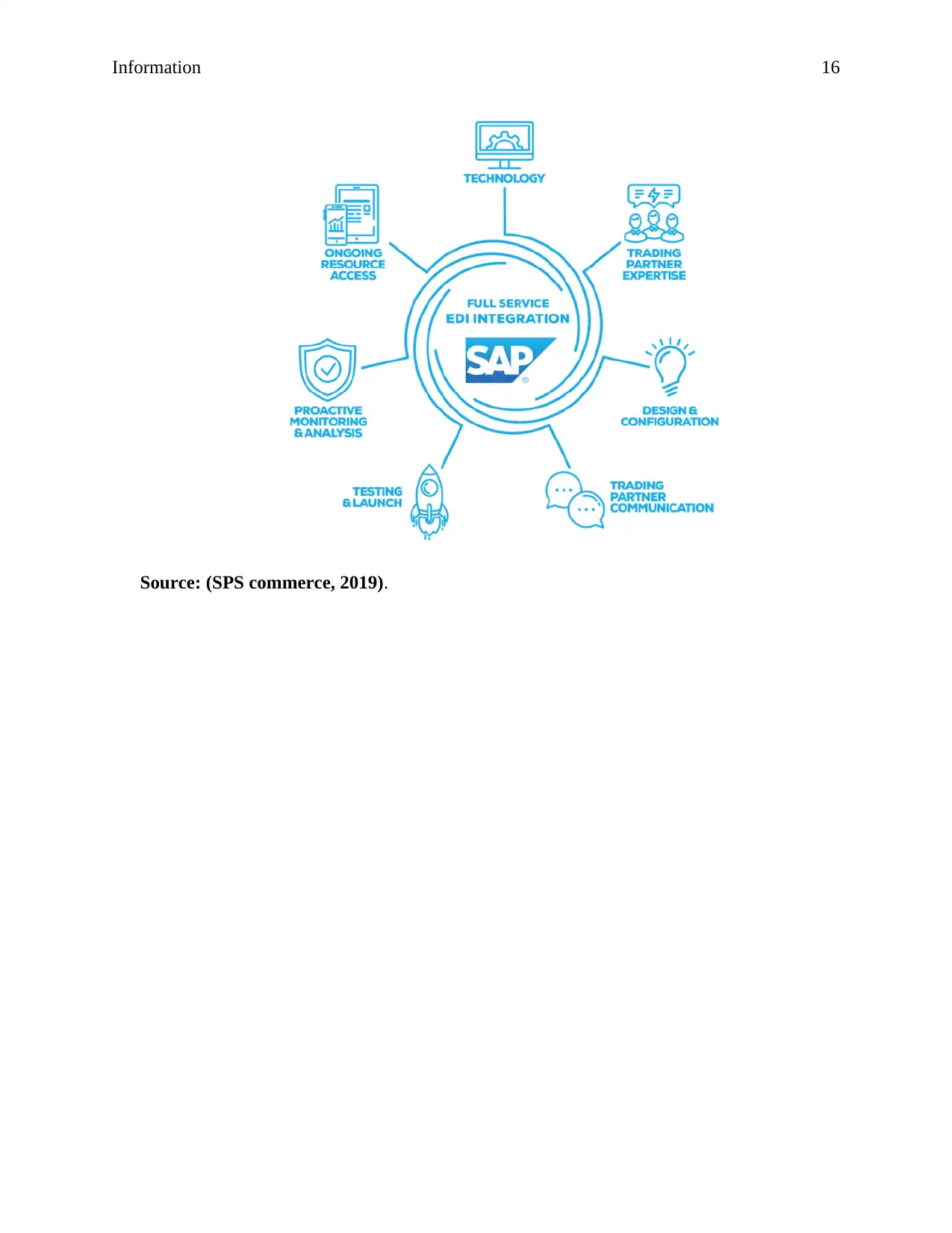
Information 16
Source: (SPS commerce, 2019).
Source: (SPS commerce, 2019).
Secure Best Marks with AI Grader
Need help grading? Try our AI Grader for instant feedback on your assignments.
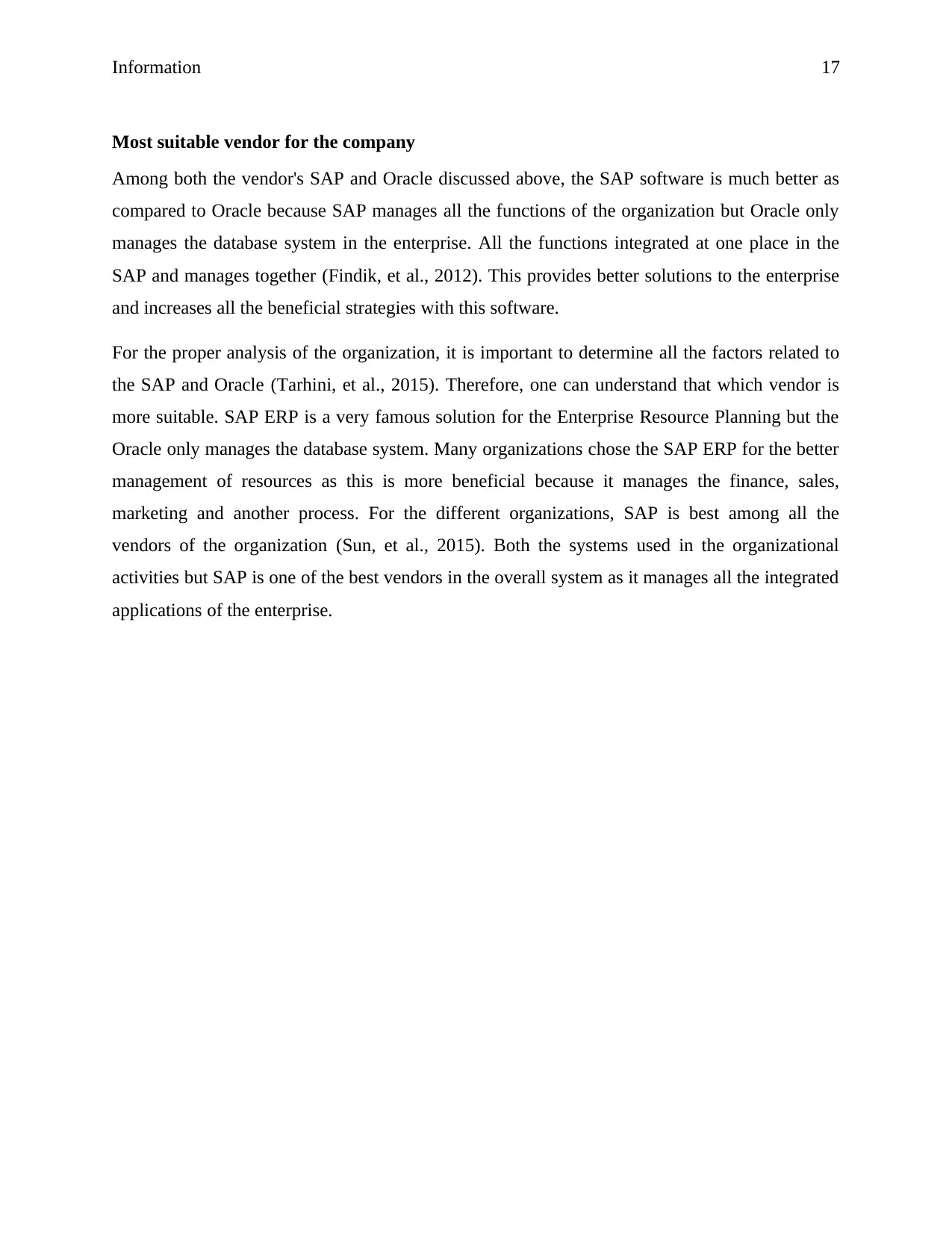
Information 17
Most suitable vendor for the company
Among both the vendor's SAP and Oracle discussed above, the SAP software is much better as
compared to Oracle because SAP manages all the functions of the organization but Oracle only
manages the database system in the enterprise. All the functions integrated at one place in the
SAP and manages together (Findik, et al., 2012). This provides better solutions to the enterprise
and increases all the beneficial strategies with this software.
For the proper analysis of the organization, it is important to determine all the factors related to
the SAP and Oracle (Tarhini, et al., 2015). Therefore, one can understand that which vendor is
more suitable. SAP ERP is a very famous solution for the Enterprise Resource Planning but the
Oracle only manages the database system. Many organizations chose the SAP ERP for the better
management of resources as this is more beneficial because it manages the finance, sales,
marketing and another process. For the different organizations, SAP is best among all the
vendors of the organization (Sun, et al., 2015). Both the systems used in the organizational
activities but SAP is one of the best vendors in the overall system as it manages all the integrated
applications of the enterprise.
Most suitable vendor for the company
Among both the vendor's SAP and Oracle discussed above, the SAP software is much better as
compared to Oracle because SAP manages all the functions of the organization but Oracle only
manages the database system in the enterprise. All the functions integrated at one place in the
SAP and manages together (Findik, et al., 2012). This provides better solutions to the enterprise
and increases all the beneficial strategies with this software.
For the proper analysis of the organization, it is important to determine all the factors related to
the SAP and Oracle (Tarhini, et al., 2015). Therefore, one can understand that which vendor is
more suitable. SAP ERP is a very famous solution for the Enterprise Resource Planning but the
Oracle only manages the database system. Many organizations chose the SAP ERP for the better
management of resources as this is more beneficial because it manages the finance, sales,
marketing and another process. For the different organizations, SAP is best among all the
vendors of the organization (Sun, et al., 2015). Both the systems used in the organizational
activities but SAP is one of the best vendors in the overall system as it manages all the integrated
applications of the enterprise.
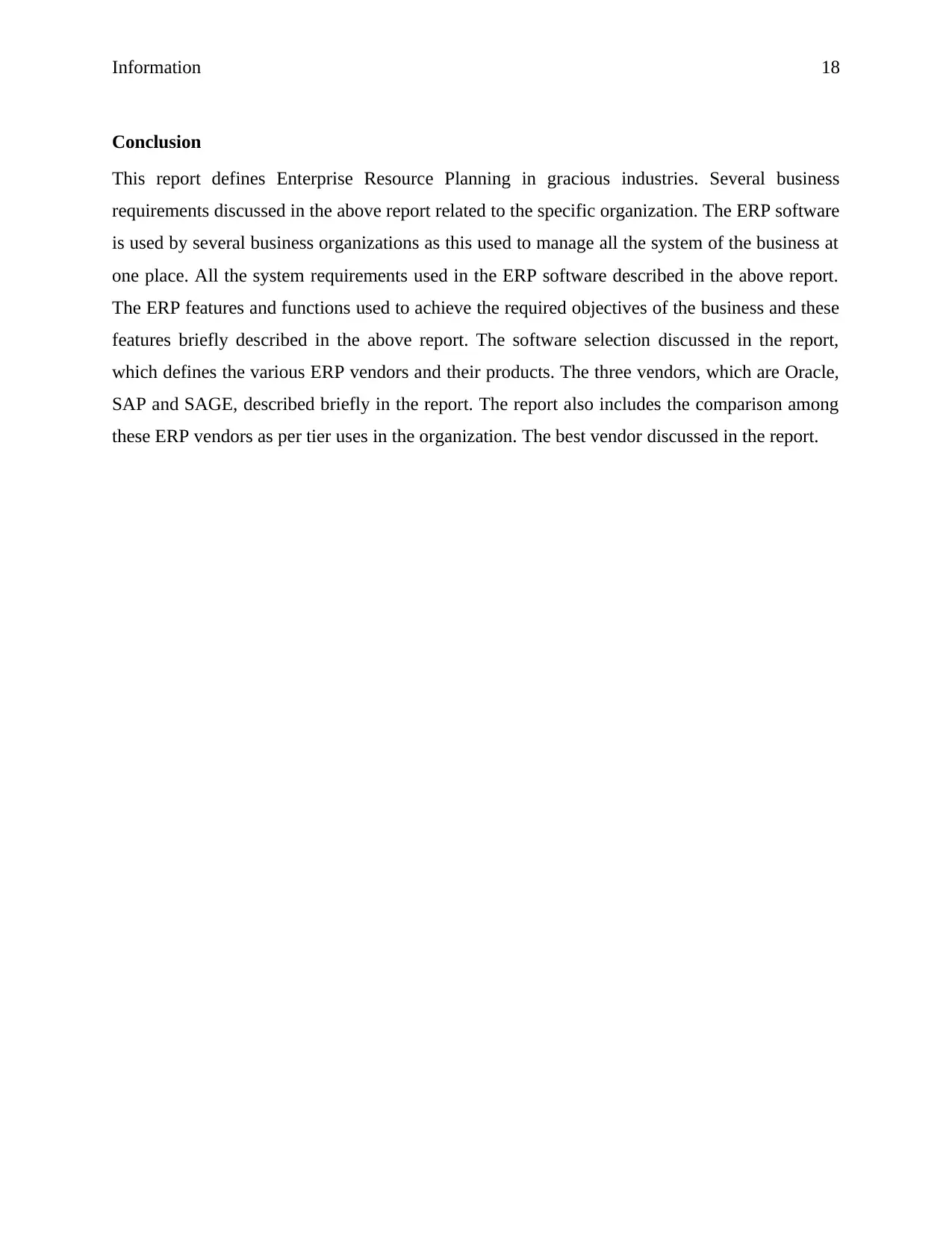
Information 18
Conclusion
This report defines Enterprise Resource Planning in gracious industries. Several business
requirements discussed in the above report related to the specific organization. The ERP software
is used by several business organizations as this used to manage all the system of the business at
one place. All the system requirements used in the ERP software described in the above report.
The ERP features and functions used to achieve the required objectives of the business and these
features briefly described in the above report. The software selection discussed in the report,
which defines the various ERP vendors and their products. The three vendors, which are Oracle,
SAP and SAGE, described briefly in the report. The report also includes the comparison among
these ERP vendors as per tier uses in the organization. The best vendor discussed in the report.
Conclusion
This report defines Enterprise Resource Planning in gracious industries. Several business
requirements discussed in the above report related to the specific organization. The ERP software
is used by several business organizations as this used to manage all the system of the business at
one place. All the system requirements used in the ERP software described in the above report.
The ERP features and functions used to achieve the required objectives of the business and these
features briefly described in the above report. The software selection discussed in the report,
which defines the various ERP vendors and their products. The three vendors, which are Oracle,
SAP and SAGE, described briefly in the report. The report also includes the comparison among
these ERP vendors as per tier uses in the organization. The best vendor discussed in the report.
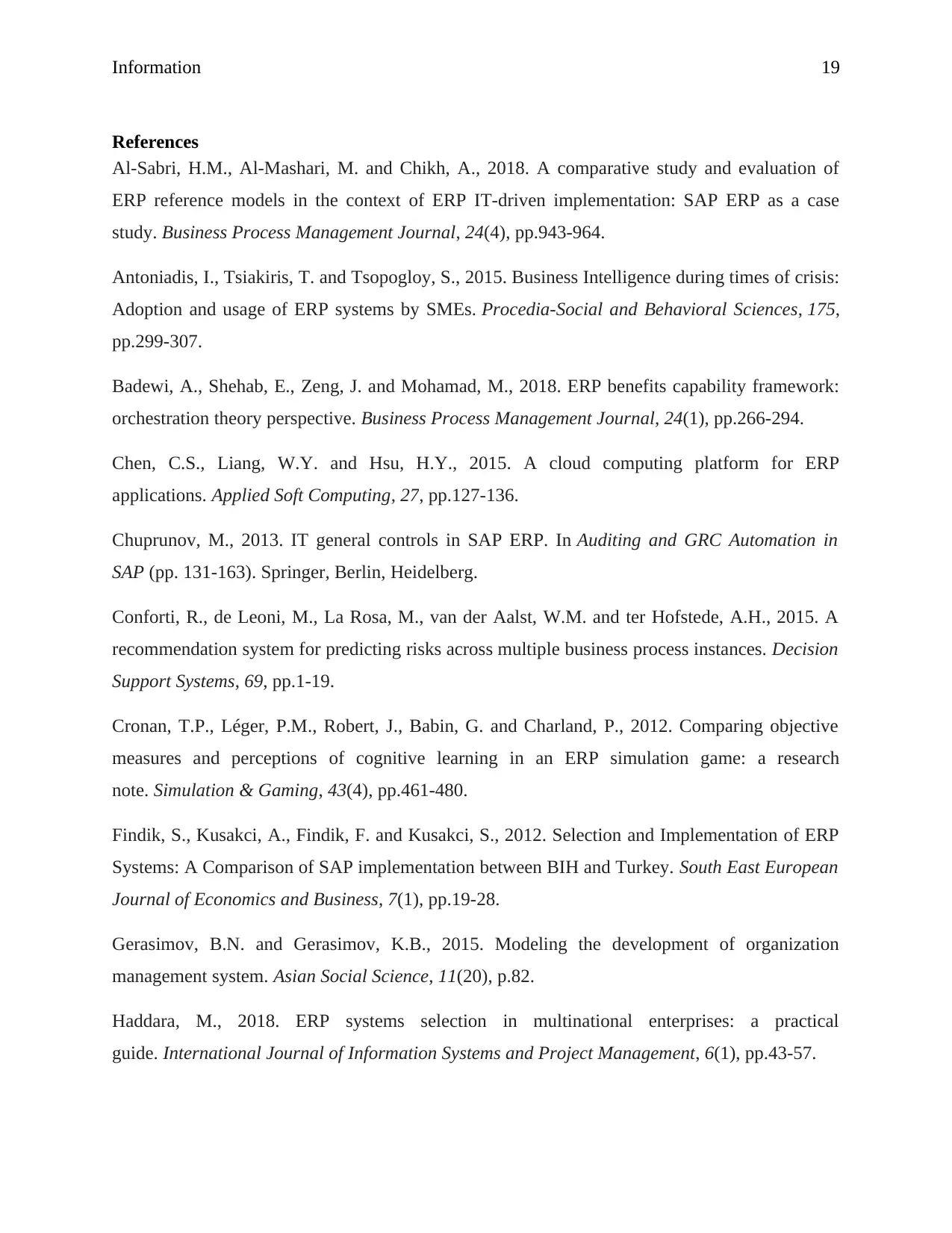
Information 19
References
Al-Sabri, H.M., Al-Mashari, M. and Chikh, A., 2018. A comparative study and evaluation of
ERP reference models in the context of ERP IT-driven implementation: SAP ERP as a case
study. Business Process Management Journal, 24(4), pp.943-964.
Antoniadis, I., Tsiakiris, T. and Tsopogloy, S., 2015. Business Intelligence during times of crisis:
Adoption and usage of ERP systems by SMEs. Procedia-Social and Behavioral Sciences, 175,
pp.299-307.
Badewi, A., Shehab, E., Zeng, J. and Mohamad, M., 2018. ERP benefits capability framework:
orchestration theory perspective. Business Process Management Journal, 24(1), pp.266-294.
Chen, C.S., Liang, W.Y. and Hsu, H.Y., 2015. A cloud computing platform for ERP
applications. Applied Soft Computing, 27, pp.127-136.
Chuprunov, M., 2013. IT general controls in SAP ERP. In Auditing and GRC Automation in
SAP (pp. 131-163). Springer, Berlin, Heidelberg.
Conforti, R., de Leoni, M., La Rosa, M., van der Aalst, W.M. and ter Hofstede, A.H., 2015. A
recommendation system for predicting risks across multiple business process instances. Decision
Support Systems, 69, pp.1-19.
Cronan, T.P., Léger, P.M., Robert, J., Babin, G. and Charland, P., 2012. Comparing objective
measures and perceptions of cognitive learning in an ERP simulation game: a research
note. Simulation & Gaming, 43(4), pp.461-480.
Findik, S., Kusakci, A., Findik, F. and Kusakci, S., 2012. Selection and Implementation of ERP
Systems: A Comparison of SAP implementation between BIH and Turkey. South East European
Journal of Economics and Business, 7(1), pp.19-28.
Gerasimov, B.N. and Gerasimov, K.B., 2015. Modeling the development of organization
management system. Asian Social Science, 11(20), p.82.
Haddara, M., 2018. ERP systems selection in multinational enterprises: a practical
guide. International Journal of Information Systems and Project Management, 6(1), pp.43-57.
References
Al-Sabri, H.M., Al-Mashari, M. and Chikh, A., 2018. A comparative study and evaluation of
ERP reference models in the context of ERP IT-driven implementation: SAP ERP as a case
study. Business Process Management Journal, 24(4), pp.943-964.
Antoniadis, I., Tsiakiris, T. and Tsopogloy, S., 2015. Business Intelligence during times of crisis:
Adoption and usage of ERP systems by SMEs. Procedia-Social and Behavioral Sciences, 175,
pp.299-307.
Badewi, A., Shehab, E., Zeng, J. and Mohamad, M., 2018. ERP benefits capability framework:
orchestration theory perspective. Business Process Management Journal, 24(1), pp.266-294.
Chen, C.S., Liang, W.Y. and Hsu, H.Y., 2015. A cloud computing platform for ERP
applications. Applied Soft Computing, 27, pp.127-136.
Chuprunov, M., 2013. IT general controls in SAP ERP. In Auditing and GRC Automation in
SAP (pp. 131-163). Springer, Berlin, Heidelberg.
Conforti, R., de Leoni, M., La Rosa, M., van der Aalst, W.M. and ter Hofstede, A.H., 2015. A
recommendation system for predicting risks across multiple business process instances. Decision
Support Systems, 69, pp.1-19.
Cronan, T.P., Léger, P.M., Robert, J., Babin, G. and Charland, P., 2012. Comparing objective
measures and perceptions of cognitive learning in an ERP simulation game: a research
note. Simulation & Gaming, 43(4), pp.461-480.
Findik, S., Kusakci, A., Findik, F. and Kusakci, S., 2012. Selection and Implementation of ERP
Systems: A Comparison of SAP implementation between BIH and Turkey. South East European
Journal of Economics and Business, 7(1), pp.19-28.
Gerasimov, B.N. and Gerasimov, K.B., 2015. Modeling the development of organization
management system. Asian Social Science, 11(20), p.82.
Haddara, M., 2018. ERP systems selection in multinational enterprises: a practical
guide. International Journal of Information Systems and Project Management, 6(1), pp.43-57.
Paraphrase This Document
Need a fresh take? Get an instant paraphrase of this document with our AI Paraphraser
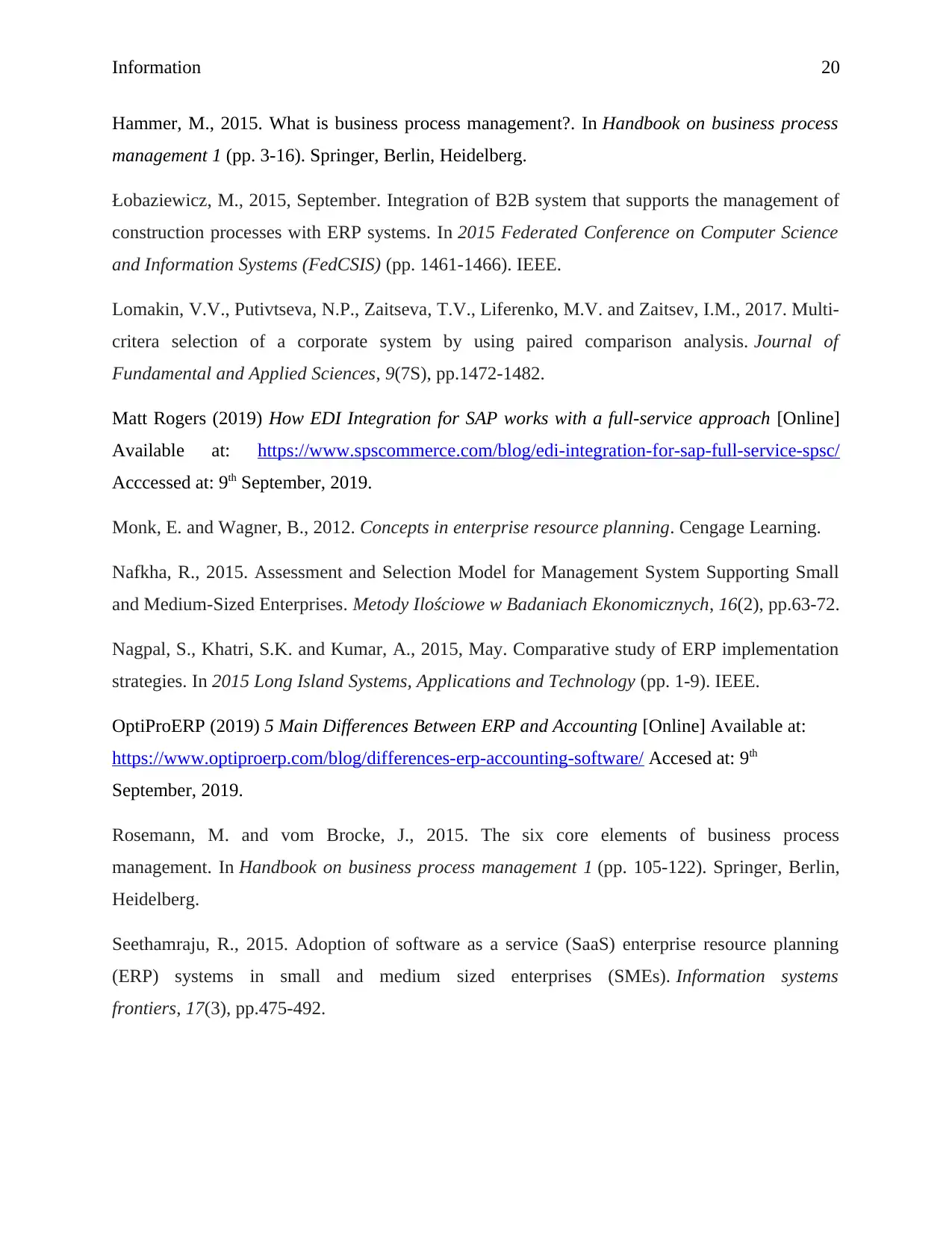
Information 20
Hammer, M., 2015. What is business process management?. In Handbook on business process
management 1 (pp. 3-16). Springer, Berlin, Heidelberg.
Łobaziewicz, M., 2015, September. Integration of B2B system that supports the management of
construction processes with ERP systems. In 2015 Federated Conference on Computer Science
and Information Systems (FedCSIS) (pp. 1461-1466). IEEE.
Lomakin, V.V., Putivtseva, N.P., Zaitseva, T.V., Liferenko, M.V. and Zaitsev, I.M., 2017. Multi-
critera selection of a corporate system by using paired comparison analysis. Journal of
Fundamental and Applied Sciences, 9(7S), pp.1472-1482.
Matt Rogers (2019) How EDI Integration for SAP works with a full-service approach [Online]
Available at: https://www.spscommerce.com/blog/edi-integration-for-sap-full-service-spsc/
Acccessed at: 9th September, 2019.
Monk, E. and Wagner, B., 2012. Concepts in enterprise resource planning. Cengage Learning.
Nafkha, R., 2015. Assessment and Selection Model for Management System Supporting Small
and Medium-Sized Enterprises. Metody Ilościowe w Badaniach Ekonomicznych, 16(2), pp.63-72.
Nagpal, S., Khatri, S.K. and Kumar, A., 2015, May. Comparative study of ERP implementation
strategies. In 2015 Long Island Systems, Applications and Technology (pp. 1-9). IEEE.
OptiProERP (2019) 5 Main Differences Between ERP and Accounting [Online] Available at:
https://www.optiproerp.com/blog/differences-erp-accounting-software/ Accesed at: 9th
September, 2019.
Rosemann, M. and vom Brocke, J., 2015. The six core elements of business process
management. In Handbook on business process management 1 (pp. 105-122). Springer, Berlin,
Heidelberg.
Seethamraju, R., 2015. Adoption of software as a service (SaaS) enterprise resource planning
(ERP) systems in small and medium sized enterprises (SMEs). Information systems
frontiers, 17(3), pp.475-492.
Hammer, M., 2015. What is business process management?. In Handbook on business process
management 1 (pp. 3-16). Springer, Berlin, Heidelberg.
Łobaziewicz, M., 2015, September. Integration of B2B system that supports the management of
construction processes with ERP systems. In 2015 Federated Conference on Computer Science
and Information Systems (FedCSIS) (pp. 1461-1466). IEEE.
Lomakin, V.V., Putivtseva, N.P., Zaitseva, T.V., Liferenko, M.V. and Zaitsev, I.M., 2017. Multi-
critera selection of a corporate system by using paired comparison analysis. Journal of
Fundamental and Applied Sciences, 9(7S), pp.1472-1482.
Matt Rogers (2019) How EDI Integration for SAP works with a full-service approach [Online]
Available at: https://www.spscommerce.com/blog/edi-integration-for-sap-full-service-spsc/
Acccessed at: 9th September, 2019.
Monk, E. and Wagner, B., 2012. Concepts in enterprise resource planning. Cengage Learning.
Nafkha, R., 2015. Assessment and Selection Model for Management System Supporting Small
and Medium-Sized Enterprises. Metody Ilościowe w Badaniach Ekonomicznych, 16(2), pp.63-72.
Nagpal, S., Khatri, S.K. and Kumar, A., 2015, May. Comparative study of ERP implementation
strategies. In 2015 Long Island Systems, Applications and Technology (pp. 1-9). IEEE.
OptiProERP (2019) 5 Main Differences Between ERP and Accounting [Online] Available at:
https://www.optiproerp.com/blog/differences-erp-accounting-software/ Accesed at: 9th
September, 2019.
Rosemann, M. and vom Brocke, J., 2015. The six core elements of business process
management. In Handbook on business process management 1 (pp. 105-122). Springer, Berlin,
Heidelberg.
Seethamraju, R., 2015. Adoption of software as a service (SaaS) enterprise resource planning
(ERP) systems in small and medium sized enterprises (SMEs). Information systems
frontiers, 17(3), pp.475-492.
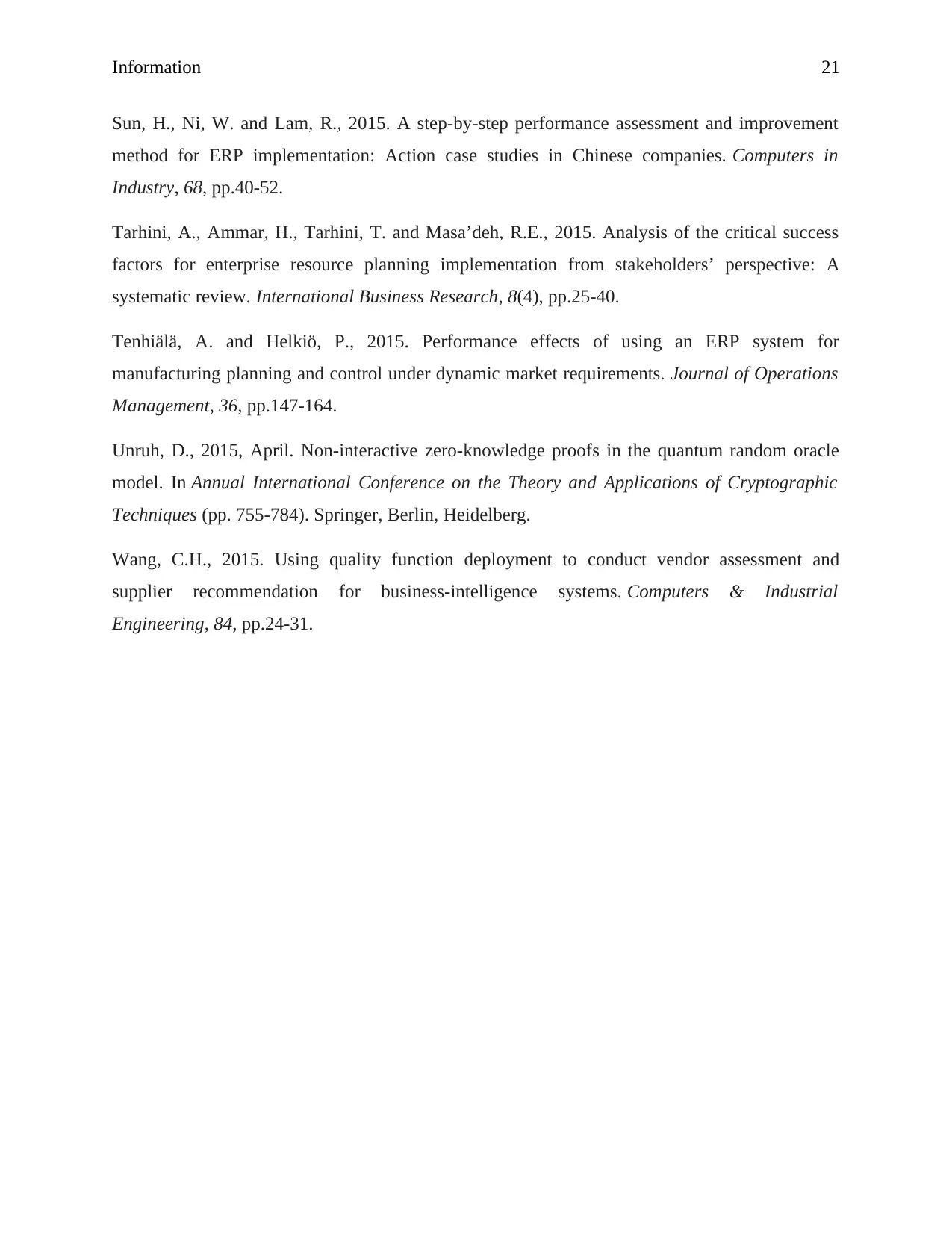
Information 21
Sun, H., Ni, W. and Lam, R., 2015. A step-by-step performance assessment and improvement
method for ERP implementation: Action case studies in Chinese companies. Computers in
Industry, 68, pp.40-52.
Tarhini, A., Ammar, H., Tarhini, T. and Masa’deh, R.E., 2015. Analysis of the critical success
factors for enterprise resource planning implementation from stakeholders’ perspective: A
systematic review. International Business Research, 8(4), pp.25-40.
Tenhiälä, A. and Helkiö, P., 2015. Performance effects of using an ERP system for
manufacturing planning and control under dynamic market requirements. Journal of Operations
Management, 36, pp.147-164.
Unruh, D., 2015, April. Non-interactive zero-knowledge proofs in the quantum random oracle
model. In Annual International Conference on the Theory and Applications of Cryptographic
Techniques (pp. 755-784). Springer, Berlin, Heidelberg.
Wang, C.H., 2015. Using quality function deployment to conduct vendor assessment and
supplier recommendation for business-intelligence systems. Computers & Industrial
Engineering, 84, pp.24-31.
Sun, H., Ni, W. and Lam, R., 2015. A step-by-step performance assessment and improvement
method for ERP implementation: Action case studies in Chinese companies. Computers in
Industry, 68, pp.40-52.
Tarhini, A., Ammar, H., Tarhini, T. and Masa’deh, R.E., 2015. Analysis of the critical success
factors for enterprise resource planning implementation from stakeholders’ perspective: A
systematic review. International Business Research, 8(4), pp.25-40.
Tenhiälä, A. and Helkiö, P., 2015. Performance effects of using an ERP system for
manufacturing planning and control under dynamic market requirements. Journal of Operations
Management, 36, pp.147-164.
Unruh, D., 2015, April. Non-interactive zero-knowledge proofs in the quantum random oracle
model. In Annual International Conference on the Theory and Applications of Cryptographic
Techniques (pp. 755-784). Springer, Berlin, Heidelberg.
Wang, C.H., 2015. Using quality function deployment to conduct vendor assessment and
supplier recommendation for business-intelligence systems. Computers & Industrial
Engineering, 84, pp.24-31.
1 out of 21
Related Documents
Your All-in-One AI-Powered Toolkit for Academic Success.
+13062052269
info@desklib.com
Available 24*7 on WhatsApp / Email
![[object Object]](/_next/static/media/star-bottom.7253800d.svg)
Unlock your academic potential
© 2024 | Zucol Services PVT LTD | All rights reserved.





